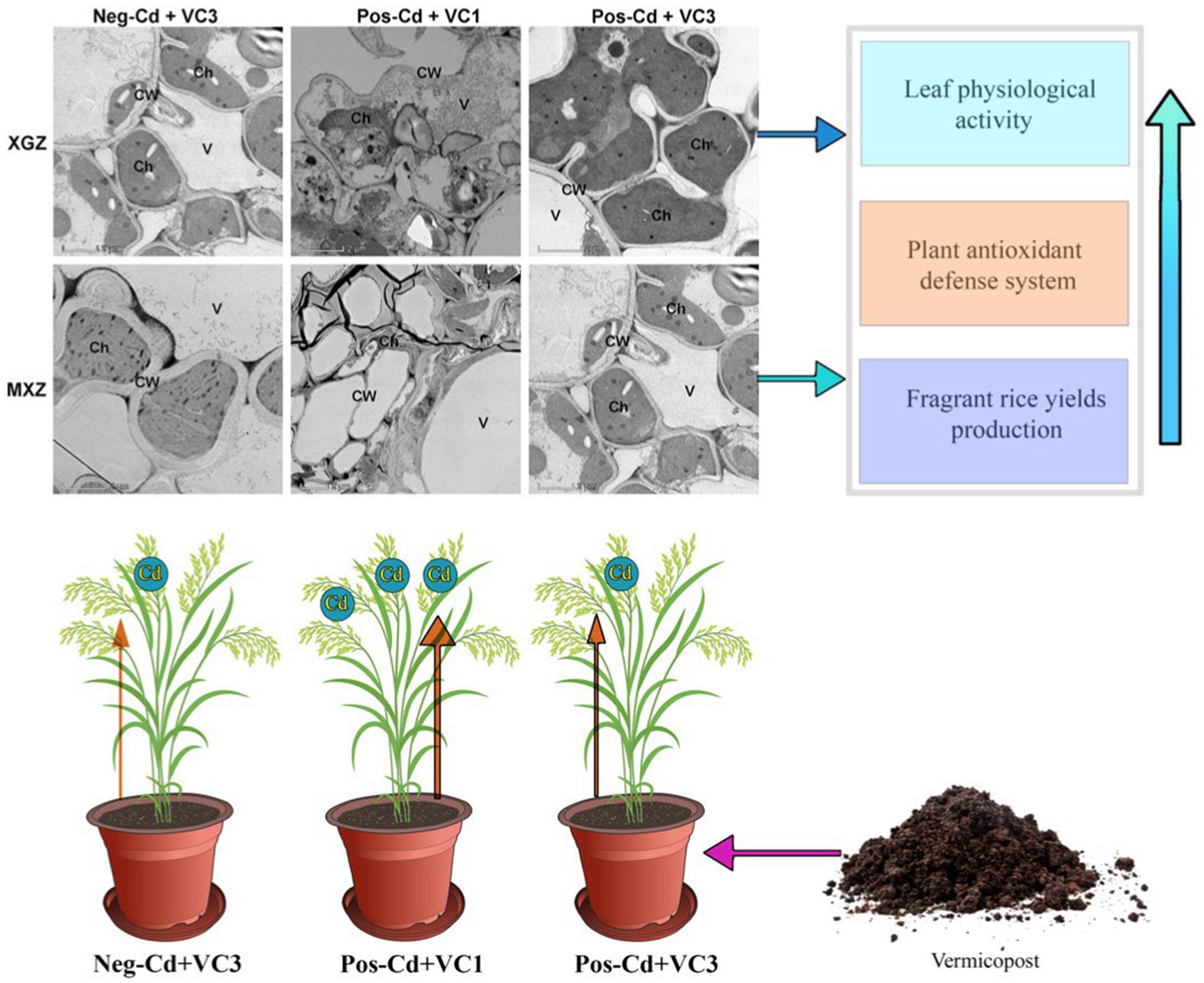- 1State Key Laboratory for Conservation and Utilization of Subtropical Agro-Bioresources, College of Agriculture, South China Agricultural University, Guangzhou, China
- 2Department of Agriculture, The University of Swabi, Swabi, Pakistan
- 3Key Laboratory of Crop Cultivation and Physiology, College of Agriculture, Guangxi University, Nanning, China
- 4College of Life Sciences and Oceanography, Shenzhen University, Shenzhen, China
- 5Centre of Excellence in Biotechnology Research, King Saud University, Riyadh, Saudi Arabia
- 6Department of Botany and Microbiology, College of Science, King Saud University, Riyadh, Saudi Arabia
- 7Department of Agronomy, Faculty of Agriculture, Kafrelsheikh University, Kafrelsheikh, Egypt
- 8CFAES Rattan Lal Center for Carbon Management and Sequestration, The Ohio State University, Columbus, OH, United States
Cadmium (Cd) contamination in agricultural soils and its accumulation in plant organs have become a global issue due to its harmful effects on human health. The in-situ stabilizing technique, which involves using organic amendments, is commonly employed for removing Cd from agricultural soils. Thus, the current study investigated the effect of vermicompost (VC) on soil properties and plant physio-biochemical attributes, leaf ultrastructure analysis, antioxidant defense mechanisms, and grain yields of two different fragrant rice cultivars, Xiangyaxiangzhan (XGZ) and Meixiangzhan-2 (MXZ-2), under Cd-stress conditions. The results showed that Cd toxicity deteriorates soil quality, the plant’s photosynthetic apparatus, and the plant’s antioxidant defense mechanism. Moreover, under Cd stress, both cultivars produced significantly lower (p < 0.05) rice grain yields compared to non-Cd stress conditions. However, the VC application alleviated the Cd toxicity and improved soil qualitative traits, such as soil organic carbon, available nitrogen, total nitrogen, phosphorus, and potassium. Similarly, VC amendments improved leaf physiological activity, photosynthetic apparatus function, antioxidant enzyme activities and its related gene expression under Cd stress These enhancements led to increased grain yields of both fragrant under Cd toxicity. The addition of VC mitigated the adverse effects of Cd on the leaf chloroplast structure by reducing Cd uptake and accumulation in tissues. This helped prevent Cd-induced peroxidation damage to leaf membrane lipids by increasing the activities of antioxidant enzymes such as ascorbate peroxidase (APX), catalase (CAT), peroxidase (POD), and superoxide dismutase (SOD). On average across the growth stages, the Pos-Cd + VC3 treatment increased SOD, APX, CAT, and POD activities by122.2 and 112.5%, 118.6, and 120.6%, 44.6 and 40.6%, and 38.6 and 33.2% in MXZ-2 and XGZ, respectively, compared to the plants treated with Pos-Cd treated alone. Enhancements in leaf physiological activity and plant antioxidant enzyme activity strengthen the plant’s antioxidant defense mechanism against Cd toxicity. In addition, correlation analysis showed a strong relationship between the leaf net photosynthetic rate and soil chemical attributes, suggesting that improved soil fertility enhances leaf physiological activity and boosts rice grain yields. Of the treatments, Pos-Cd + VC3 proved to be the most effective treatment in terms of enhancing soil health and achieving high fragrant rice yields. Thus, the outcomes of this study show that the addition of VC in Cd-contaminated soils could be useful for sustainable rice production and safe utilization of Cd-polluted soil.
1 Introduction
Heavy metals, especially Cd, pose significant hazards due to their high toxicity and propensity for substantial uptake and accumulation in cereal grains (Singh et al., 2020). The Cd accumulation in arable soil is caused by industrial processes such as waste discharge, fertilization, mining, and smelting (Islam et al., 2017; Tang et al., 2019; Seleiman et al., 2020). Cd is more soluble and mobile than other metals, making it easily absorbed by plants, translocated within them, and deposited in various plant parts (Chen Q. et al., 2018; Chen Y. et al., 2018; Adil et al., 2020). Furthermore, Cd is commonly non-recyclable and difficult to remove from the soil, and it can migrate to cereal grains via the soil–plant-food cycle, thereby posing health hazards to humans (Rizwan et al., 2016; Seleiman et al., 2020). The Cd inputs and availability in soil adversely affect soil microbial biodiversity and its associated ecosystem function (Xue et al., 2017; Haider et al., 2021; Iqbal et al., 2024a). Cadmium garnered a lot of attention in arable soil because of its toxicity, availability, and persistence in living organisms (Rizwan et al., 2016; Huang et al., 2019).
Additionally, high Cd levels in arable fields may affect soil health, physiochemical characteristics, and plant metabolism, resulting in lower crop growth and reduced productivity (Mitra et al., 2018; Iqbal et al., 2023a). Cd also inhibits plant photosynthesis and reduces plant uptake of essential mineral nutrients, resulting in a decrease in agricultural output (Tran and Popova, 2013; Chen Q. et al., 2018; Chen Y. et al., 2018). In addition, Cd toxicity in plants can produce physiological, biochemical, and physical changes, including reduction in root growth, stomatal density, and chlorosis (Bari et al., 2019; Huybrechts et al., 2020). The plant photosynthetic apparatus is often more vulnerable to Cd-induced damage. Plant chlorophyll is essential for photosynthesis, and any decrease in plant chlorophyll production due to Cd toxicity declines the photosynthesis process (Li et al., 2010; Parmar et al., 2013). Cd stress affects mitochondrial function in plants by affecting redox control and promoting the generation of additional reactive oxygen species (ROS), that damage membrane lipids and alter overall metabolic activity (Chen Q. et al., 2018; Chen Y. et al., 2018; Huybrechts et al., 2020). The ROS generated under stress is responsible for cellular oxidative injury and genotoxicity (Gallego et al., 2012; Khan et al., 2022). As a result, Cd, one of the most harmful contaminants, demands special attention to regulate its mobility in arable soils.
Rice is an important cereal crop for about 3.5 billion people worldwide (Dabral et al., 2019). Rice is a key ingredient and staple diet for Chinese people (Chauhan et al., 2017). The majority of Cd in the food channel could come from agricultural products, and Cd in soil plants accumulates up by roots and finally enters the food, posing health concerns to the human immunological, neurological, and reproductive organs (Parmar et al., 2013; Adil et al., 2020). In situ stabilization technique, using organic additions such as cattle fertilizer, biochar, and compost, is an environmentally friendly approach to preventing Cd (Hamid et al., 2020; Ullah et al., 2020; Yuan et al., 2022; Ali et al., 2022a,b,c; Iqbal et al., 2024b). However, these techniques are ineffective and problematic because of the accompanying costs and additional pollutants (Shaheen and Rinklebe, 2015; Pramanik et al., 2018). In addition, according to Igalavithana et al. (2017) the use of these organic fertilizers alone might enhance the risk of arsenic pollution; for instance, applying wood bark organic biochar increases exchangeable arsenic in soil by 84.5%.
Vermicompost (VC), is the product of the decomposition process using species of worms, usually white worms, red wigglers, and other earthworms to create a mixture of decomposing vegetables, food waste and vermicas (Charan et al., 2024). The VC, a nutrient-rich fertilizer, is turning more common for heavy metal-contaminated arable soil rehabilitation (Wang et al., 2018; Zhang et al., 2020). Alam et al. (2020) found that VC is more beneficial and effective than wasted mushroom and organic fertilizer for reducing Cd and other metals accumulation and uptake in plants. Earthworms can accumulate various heavy metals such as Cd, Pb, Hg, and Zn, and store it in benign forms in the chloragogenous tissues (Song et al., 2015). The peak absorption rate of 170.65 mg/g of Cd2+ on VC indicates that VC is a possible in situ sorbent for Cd-polluted soil (Zhu et al., 2017). Moreover, VC treatment may affect soil physical and biochemical parameters and alter the chemical composition of Cd in soils, reducing Cd bioavailability in soils by adsorption, immobilization, and precipitation (Bradham et al., 2018; Cambier et al., 2019). After soil application, VC provides polysaccharides, the release of mucus from earthworms and microorganisms, and improves soil physical structure, i.e., aeration, porosity, aggregate stability, and drainage, all of which are beneficial to crop root growth, as well as nutrient uptake by plants (Lim et al., 2015; Hussain et al., 2021). VC is a rich source of plant micronutrients and macronutrients, hence adding VC improved the mineral elements in soils, resulting in increased plant growth and production (Maji et al., 2017; Dubey et al., 2020; Goswami et al., 2024). However, limited studies have evaluated VC’s effects on paddy soil properties, fragrant rice Cd uptake, plant physiological and antioxidant defense function, and rice production under Cd toxicity.
Given previous consideration, this research investigated the application of VC as a soil conditioner, which is a potential remediation technique in Cd-polluted fields. We used aromatic rice cultivars MXZ-2 and XGZ, which are popular in southern China due to their pleasant flavor (Luo H. et al., 2020; Luo Y. et al., 2020; Zhang et al., 2022). Rice, a semi-aquatic tropical plant grown on marshy lands, is very susceptible to Cd uptake and accumulation in organs (Wu et al., 2014). The presence of Cd in arable soil is common, particularly in China, it can be absorbed by rice plants. This metal accumulates in the grains, posing a significant threat to both the quality and nutritional value of rice. This contamination adversely affects human health and crop production (Zeng et al., 2019; Adil et al., 2024). High concentrations of Cd in rice grains not only alter their taste and texture but also diminish their nutritional content (Bin Rahman and Zhang, 2023). Consumption of Cd-contaminated rice grains can lead to health issues such as kidney damage, skeletal abnormalities, and potentially cancer (Song et al., 2015). Therefore, addressing Cd toxicity in rice cultivation is crucial for ensuring the food safety and nutritional security of communities globally. In this study, we applied VC as a composite material in Cd-contaminated soil to counteract the negative impacts of Cd on soil fertility, plant physiological and biochemical attributes, and grain yield. To the best of our knowledge, there is a lake of knowledge regarding the measured variables in this study in the context of soil and fragrant rice crops relative to different VC amendments under Cd toxicity conditions. The main objectives of the study were: (1) to investigate the impacts of VC on soil environmental parameters and soil fertility (2) to assess the role of VC in plant physiology, especially its impact on photosynthetic performance and leaf ultrastructure (i.e., chloroplast, cell wall, and vacuole), and biochemical attributes (3) to explore the effect of VC application on fragrant-rice yield and the role of soil fertility in plant physiological and biochemical activity. The present work hypothesized that applying VC can improve soil health which in turn increases plant physiological activity and antioxidant defense systems under Cd toxicity. This work will produce a conceptual framework for safe and sustainable crop production in Cd-contaminated soils.
2 Materials and methods
2.1 Experimental place and basic soil qualities
A pot study was carried out at the South China Agriculture University Research Station. The soil of the experimental site (0–15 cm) is slightly acidic, with a pH of 5.88. Furthermore, the soil has 23.75 g kg−1 organic matter, 1.18 g kg−1 TN, 145.40 mg kg−1 available N, and 0.98 g kg−1 phosphorus. Supplementary Table S1 also includes details about the soil’s qualities.
2.2 Experimental details
In the present research, we used two different fragrant rice varieties, MXZ-2 and XGZ, which respond differently to Cd-stress conditions (Imran et al., 2020). Both cultivars were obtained from the College of Agriculture, South China Agriculture University. The experiment was conducted in complete block design in the early season of 2023 (March–July). The soil was obtained to a depth of 15 cm from the paddy field and then placed into plastic pots. Further, it was ensured that all pots contained the same size and weight of soil to minimize experimental error. The recommended dose of VC was applied 1 week ago from seedling transplantation. The applied VC was manufactured by Hubei Tianhenjia Biological Environmental Protection Technology Co., Ltd., Wuxue City, Hubei Province, China; it consisted of 34.90% organic matter, 1.48% TN, 2.76% P2O2, and 1.00% K2O, and had a pH of 7.6. Three VC rates, such as VC1 = 0 t ha−1, VC2 = 3 t ha−1, and VC3 = 6 t ha-1, and two doses of Cd (Cd, 0 and 50 mg Cd kg−1) were tested. The study included six treatments: (1) Neg-Cd + VC1 = 0 mg Cd + 0 t ha−1 VC, (2) Neg-Cd + VC2 = 0 mg Cd + 3 t ha−1 VC, (3) Neg-Cd + VC3 = 0 mg Cd + 6 t ha−1 VC, (4) Pos-Cd + VC1 = 50 mg Cd + 0 t ha−1 VC, (5) Pos-Cd + VC2 = 50 mg Cd + 3 t ha−1 VC, and (6) Pos-Cd + VC3 = 50 mg Cd + 6 t ha−1 VC. The seeds of the fragrant rice cultivars were used as a test crop and cultivated in a plastic pot, with each pot containing three hills. The seedlings were transplanted into pots in mid-March, and the rice crops were harvested in mid-July. The NPK dose was 300:150:300 (kg ha−1) 1.80 g of N was used as urea, 0.90 g of P2O2 as superphosphate, and 2.20 g of potassium chloride. Uniform flooding irrigation was maintained from the planting of seedlings to physiological maturity to establish anaerobic conditions in the pots. Usual farming practices, such as insecticide and pesticide application, were applied in all treatments.
2.3 Sampling and analysis
2.3.1 Soil chemical attributes
A core sampler was used to gather soil samples at a depth of 15 cm before to seedlings and after harvest. The samples were then separated into two separate portions, one half for soil nutritional evaluations and the other for molecular analysis and stored at −80°C. Soil organic C (SOC) was examined using the K2Cr2O7-H2SO4 oxidation method posted by Wang et al. (2003). Furthermore, the Ohyama (1991) approach was employed for TN. The TN was determined using Jackson’s (1956) micro-Kjeldahl technique. Finally, Lu’s (2000) techniques evaluated soil pH, AN, TP, and TK.
2.3.2 Rice grain yield and leaf physiological attributes
At maturity, rice plants from the pot were picked to examine grain yield adjusted to 14% moisture content. Moreover, at the tillering and heading stages, several gaseous exchange parameters were examined, including transpiration rate (Tr), net photosynthetic rate (Pn), intercellular CO2 concentration (Ci), and stomatal conductance (gs). On a sunny day, a transportable photosynthesis machine (Li-6800, Li-COR USA) was utilized to measure photosynthesis.
Fresh leaf samples (size 1 mm2) were chosen for transmission electron microscope (TEM) analysis. Small slices of leaves, about 1–3 mm, were fixed in 4% glutaraldehyde (v/v) in 0.2 mol/L PBS (sodium phosphate buffer, pH 7.2) for 6–8 h, then in 1% OsO4 for 1 h, and finally in 0.2 mol/L PBS (pH 7.2) for 1–2 h. Dehydration was performed in a graded ethanol series (50, 60, 70, 80, 90, and 100%), followed by acetone, before samples were filtered and embedded in Spurr’s resin. Finally, ultra-thin sections (80 nm) were produced and placed on copper grids for TEM imaging (Roland and Vian, 1991).
2.3.3 Antioxidant enzyme activities
The antioxidant enzymes, such as superoxide dismutase (SOD), peroxidase (POD), catalase (CAT), and ascorbate peroxidase (APX) activities in fresh leaves were determined by using previously described by Wu et al. (2003). Briefly, fresh rice leaves were homogenized using sodium phosphate buffer (50 mM, pH 7.5). The homogenized sample was centrifuged at 12,000 rpm for 10 min at 4°C. The supernatant was then collected and used for subsequent assays. In the enzyme extract, the measurement of the activity of SOD was done using the enzyme solution containing methionine (750 mM), NBT (5.2 mM), EDTA (0.1 mM) and PBS (50 mM). The enzymatic activities of SOD, POD, CAT, and APX were measured as previously reported procedures (Jiang and Zhang, 2001).
2.3.4 Total RNA extraction and qRT-PCR analysis
Total RNA was isolated from the samples using TRIzol reagent (Invitrogen, Carlsbad, California, United States). The qRT-PCR was then evaluated using the Pfafflfl (2001) technique, as previously reported. Rice ACTIN (Os03g50885) was utilized as a reference gene for relative quantification. Supplementary Table S1 provides information about nucleotide sequences and specific annealing temperatures. Three biological repetitions were employed, and expressions were calculated by normalizing the Ct value for every gene compared to the ACTIN value. Quantification was done using the 2−∆∆Ct approach, as indicated in the previous study (Pfafflfl, 2001).
2.3.5 Measurements of MDA and H2O2
Leaf malondialdehyde (MDA) content during the vegetative and reproductive was measured by the previously reported method (Velikova et al., 2000). To measure MDA contents, fresh rice leaves were sampled and immediately homogenized in 0.1% (w/v) cold TCA, and the homogenate was centrifuged at 12,000 g for 20 min at 4°C. The reaction mixture contained 0.5 mL of supernatant, and 2.5 mL of 0.5% thiobarbituric acid (TBA) solution (dissolved in 20% TCA). The reaction mixture was boiled for 30 min, and then rapidly cooled and centrifuged for 5 min at 12,000 × g. The difference between the absorbance values at 532 and 600 nm with an extinction coefficient of 155 mM cm 1 was applied to calculate the MDA contents. In addition, hydrogen peroxide (H2O2) was investigated from the fresh samples by the technique recommended earlier (Bates et al., 1973). Fresh leaf samples (0.2 g) were crushed in liquid nitrogen and homogenized with 1 mL of 0.1% trichloroacetic acid (TCA) and centrifuged at 12,000 g for 20 min (4°C) for the measurement of hydrogen peroxide (H2O2). The reaction mixture was comprised of 0.5 mL of potassium phosphate buffer (pH 6.8, 100 mM), 1 mL potassium iodide (1 M), and 0.5 mL supernatant. The H2O2 contents were measured by spectrophotometer (UV–VIS 2550, Shimadzu, Japan) at 390 nm.
2.3.6 Assessment of proline and protein level
As stated in earlier studies, the amount of proline in fresh leaves was determined using Bradford’s (1976) technique The solution was purified with 5 mL of toluene, and the absorption of red chromophore in the methanol component was obtained at the 520 nm range. Fresh leaves (0.1 g) were standardized in 50 mM sodium phosphate buffer (1 mM EDTA-Na2, 2% polyvinyl pyrrolidine-40) and spun at 10,000 × g for 15 min at 4°C and finally, the reaction solution was scanned at 595 nm for final protein content.
2.3.7 Determination of plant cd content
The dried samples were grinded and processed at a 4:1 (v/v) ratio in HNO3 and HClO4 before being diluted up to 25 mL. Then, Cd levels in rice organs were subsequently analyzed with a flame atomic absorption spectrometer as earlier advised by Cao et al. (2014).
2.4 Statistical analysis
The results collected on soil chemical attributes and fragrant rice physiological, biochemical attributes and grain yield were analyzed using relevant ANOVA procedures for completely randomized design, using Statistix 8.1 software (Analytical Software). Before analysis, results were normalized using the arcsine function. Tukey’s post-hoc test was conducted to compare multiple means for variables with significant influence from experimental factors.
3 Results
3.1 Effect of VC on soil fertility
The addition of VC considerably enhanced soil chemical characteristics, including SOC, pH, AN, TN, TP, and TK as compared to sole Cd-stressed soil: Pos-Cd + VC1 (Table 1). The application mitigated the adverse effects of Cd on soil health, and the effect was most pronounced in all evaluated parameters at high VC amendments. Off the treatments, the non-Cd stressed soil (Neg-Cd + VC3) had higher values for soil qualitative features (i.e., pH, TN, AN, and SOC), while the solo Pos-Cd soil had the lowest values. Related to Pos-Cd + VC1, Pos-Cd + VC3 enhanced soil SOC, pH, TN, and AN by 5.78, 43.13, 178.54, and 11.38%, respectively, in Cd-contaminated soil. Likewise, low VC input increased each examined variable, although not as much as compared to VC amendments under Cd toxicity.
3.2 Effect of VC on leaf gas exchange attributes and grain yield
Fragrant rice verities, XGZ and MXZ-2, showed substantial variations in photosynthesis rate with VC application in a Cd stress condition (Figures 1, 2). In Cd-contaminated soil, the VC treatment improved leaf photosynthetic characteristics such as Pn, Tr, gs, and Ci. In addition, the treatments followed a similar pattern across both development phases. Pos-Cd + VC3 enhanced Pn and Tr by 60.66 and 42.44%, correspondingly, in MXZ-2 and 66.40 and 42.44% in the XGZ, as related compared to the High VC treatment: Pos-Cd + VC3, as shown in Figure 1. Similarly, low-VC-treated pots considerably boosted leaf physiological activity over Cd-stressed plants.
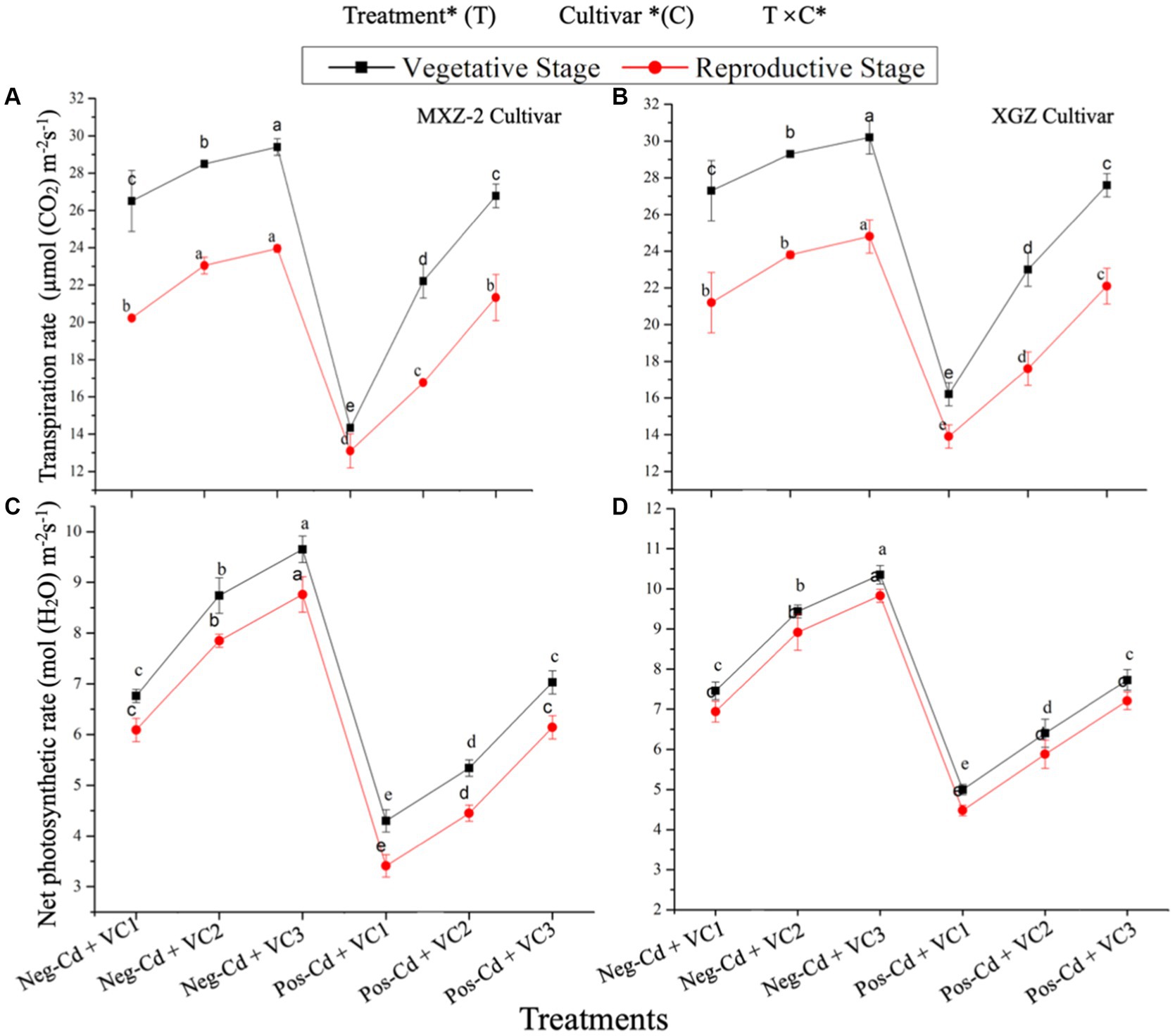
Figure 1. Effect of vermicompost application on net photosynthetic rate (A,B) and transpiration rate (C,D) of rice MXZ-2 and XGZ at different growth periods under Cd toxicity. Tukey analyses were performed to compare the means of the treatments, and the findings were interpreted using a simple test based on the Tukey HSD test at (p < 0.05). Error bars are standard errors of the mean. At p < 0.05, bars with different letters show significant (p < 0.05) differences among the treatments. ** and * indicate significance level at 1% and 5%, correspondingly. See Table 1 for treatment combination details.
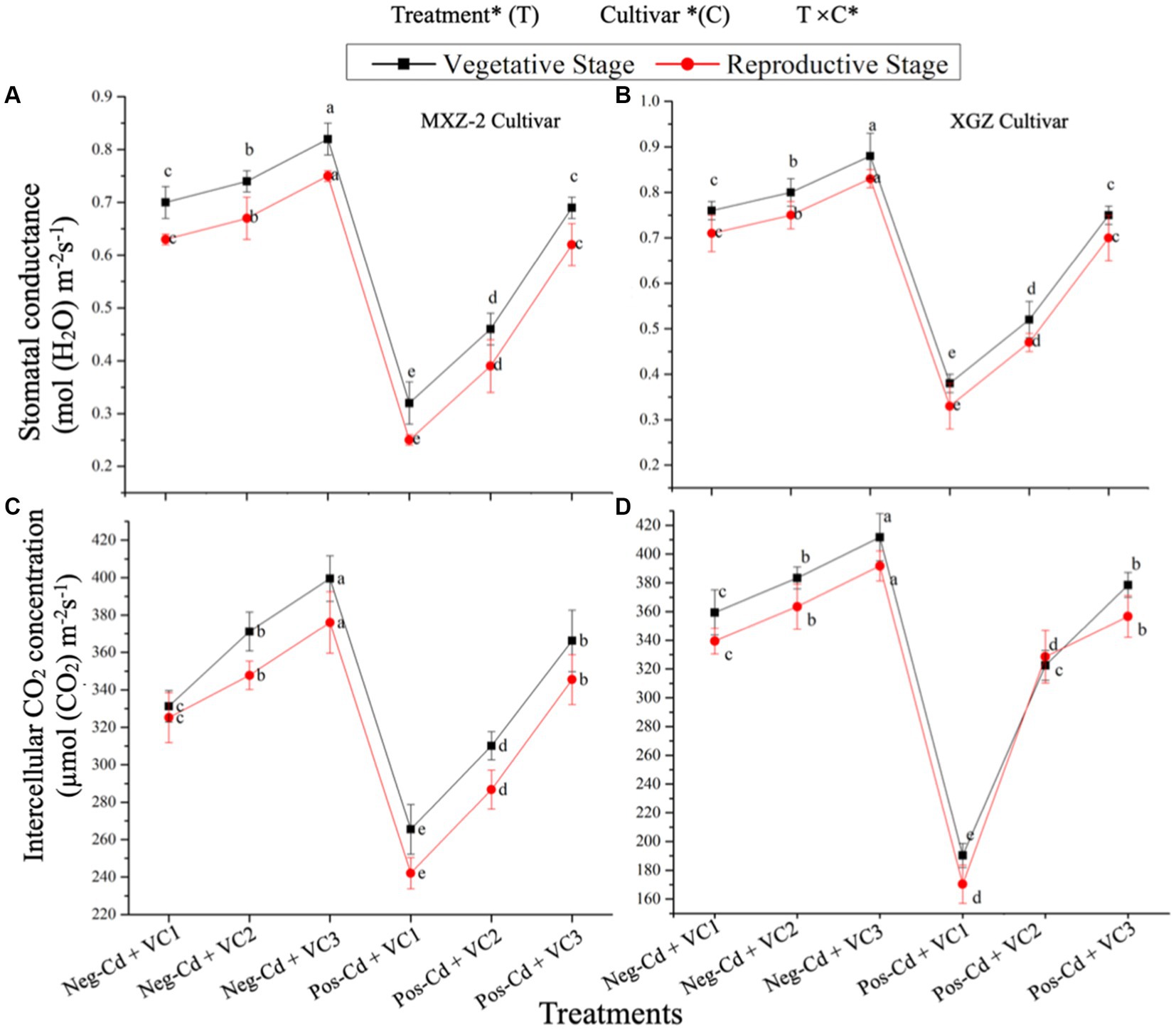
Figure 2. Effect of vermicompost application on leaf stomatal conductance (A,B) and intercellular CO2 concentration (C,D) of rice cultivars, i.e., MXZ-2 and XGZ at different growth periods under Cd toxicity. Tukey analyses were performed to relate the means of the treatments, and the findings were interpreted based on the Tukey HSD test at (p < 0.05). At p < 0.05, bars with distinct letters show significant differences among treatments. ** and * indicate significance level at 1% and 5%, respectively. See Table 1 for treatment combination details.
Across the growth, differences in gs and Ci were also substantially higher compared with Cd-stressed plants (Figures 2A–D). Across the growth stages, the Pos-Cd + VC3 enhanced gs and Ci by 60.64 and 15.30%, correspondingly, in MXZ-2 and 56.45 and 15.80%, in XGZ cultivars under Cd toxicity. Similarly, low VC-treated plants significantly (p < 0.05) increased gs and Ci than only Cd-stressed plants. Furthermore, findings showed that XGZ was more resilient to Cd stress than the MXZ-2 cultivar.
3.3 Leaf ultrastructure analysis under Cd toxicity
Plant growth and development depend primarily on cell elongation and division. In the present study, the plant physiological, biochemical, and yield improved with the addition of VC amendments. Thus, Pos-Cd + VC1, Pos-Cd + VC3, and Neg-Cd + VC3 treated plants were selected for leaf ultrastructure (TEM) analysis and analyzed the changes in the ultrastructure cells of fragrant rice leaves (Figure 3). The leaf ultrastructure analysis showed that the Cd toxicity damages the shape and size of the cell relative to High VC-treated plants: Pos-Cd + VC3 and Neg-Cd + VC3. Under no Cd stress conditions (no Cd) supplemented with vermicomposting (Neg-Cd + VC3), chloroplasts in XGZ and MXZ-2 exhibited well-organized grana and stroma lamellae, developing complete thylakoid membrane systems. However, under Cd stress (Pos-Cd + VC1), chloroplast morphology changed gradually from oblong round to expanding spindle-like shapes, with severe deformities observed in MGZ-2 such as irregular shapes with distorted plastids and dissolution of grana lamellae. In contrast, the changes in chloroplasts (thylakoid and grana lamellae) were less severe in XGZ under Cd stress. Following vermicomposting under Cd stress (Pos-Cd + VC3), chloroplasts and thylakoid membranes in MXZ-2 partially recovered, while chloroplast structures in XGZ resembled those in plants under Neg-Cd + VC3 conditions. Resultantly, vermicomposting application eased the negative effects of Cd on chloroplast structure in both varieties (XGZ and MXZ-2) of fragrant rice.
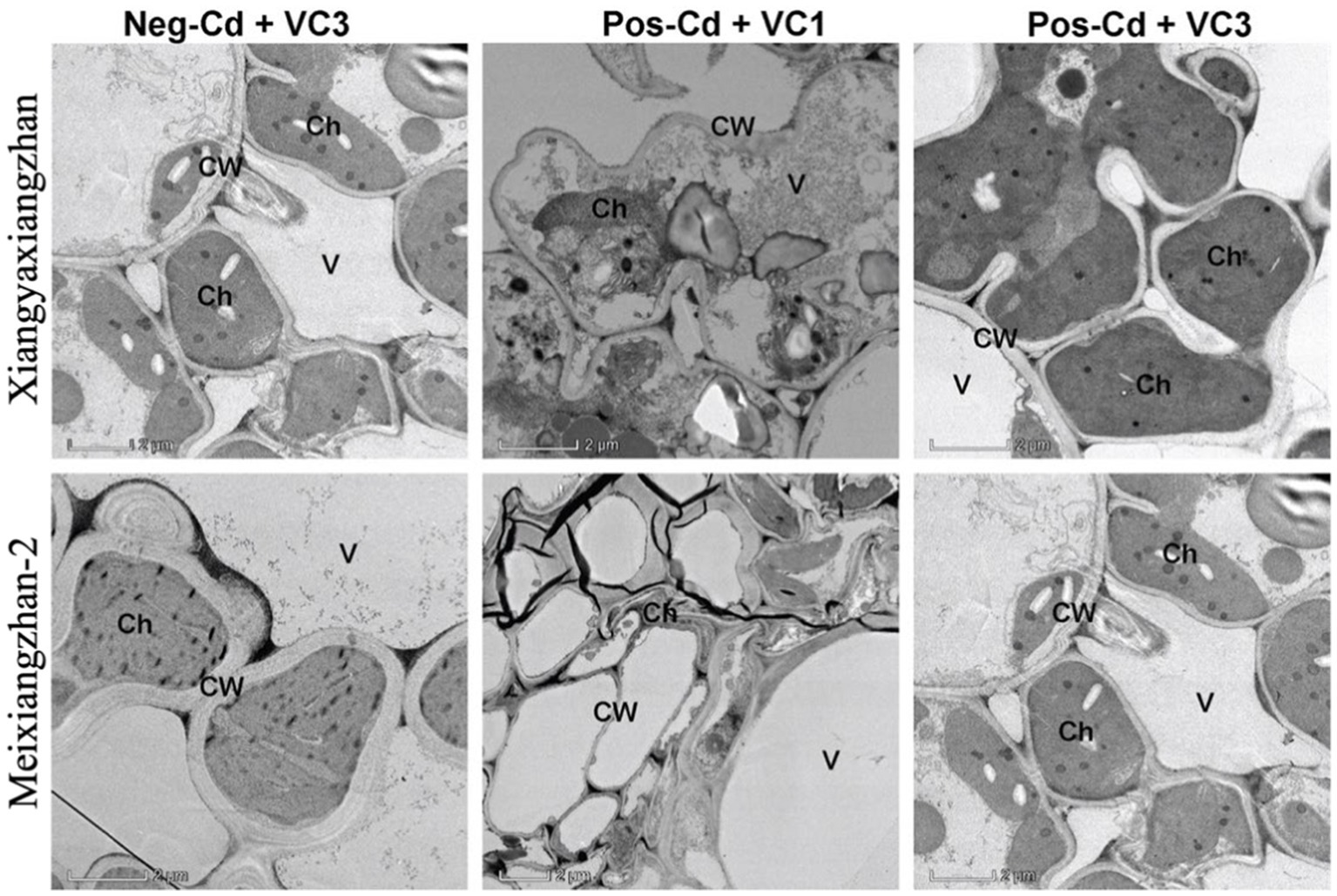
Figure 3. Effect of VC application on leaf ultrastructure analysis of rice cultivars such as Xiangyaxiangzhan and Meixiangzhan-2 under Cd toxicity. CW, cell wall; Ch, chloroplast; V, Vacuole. See Table 1 for treatment combination details.
3.4 Effect of VC application on enzyme activity
Antioxidant-related enzyme activities were investigated to determine the role of VC additions in mitigating Cd-induced oxidative stress in both varieties (Figures 4, 5). The findings demonstrated that Cd stress significantly reduced the antioxidant enzyme activity of rice cultivars than non-Cd stressed plants. Leaf antioxidants enzyme production changed substantially across cultivars, with XGZ exhibiting a slighter drop, indicating that it is more resistant to the Cd stress. Surprisingly VC application reduced Cd toxicity under High VC treatments while increasing antioxidant enzyme activities in leaves under Cd pollution. Across the development phases, the treatments followed a similar pattern. Averaged throughout development stages, Pos-CD + VC3 treatment substantially increased SOD (122.55 and 114.46%), POD (38.65 and 36.23%), CAT (42.46 and 45.66%), and APX (112.22 and 126.45%) activities in MXZ-2 and XGZ rice, respectively, related to Pos-Cd treated plants alone. Similarly, low VC-treated pots had significantly higher antioxidant enzyme activity than Cd-stressed plants.
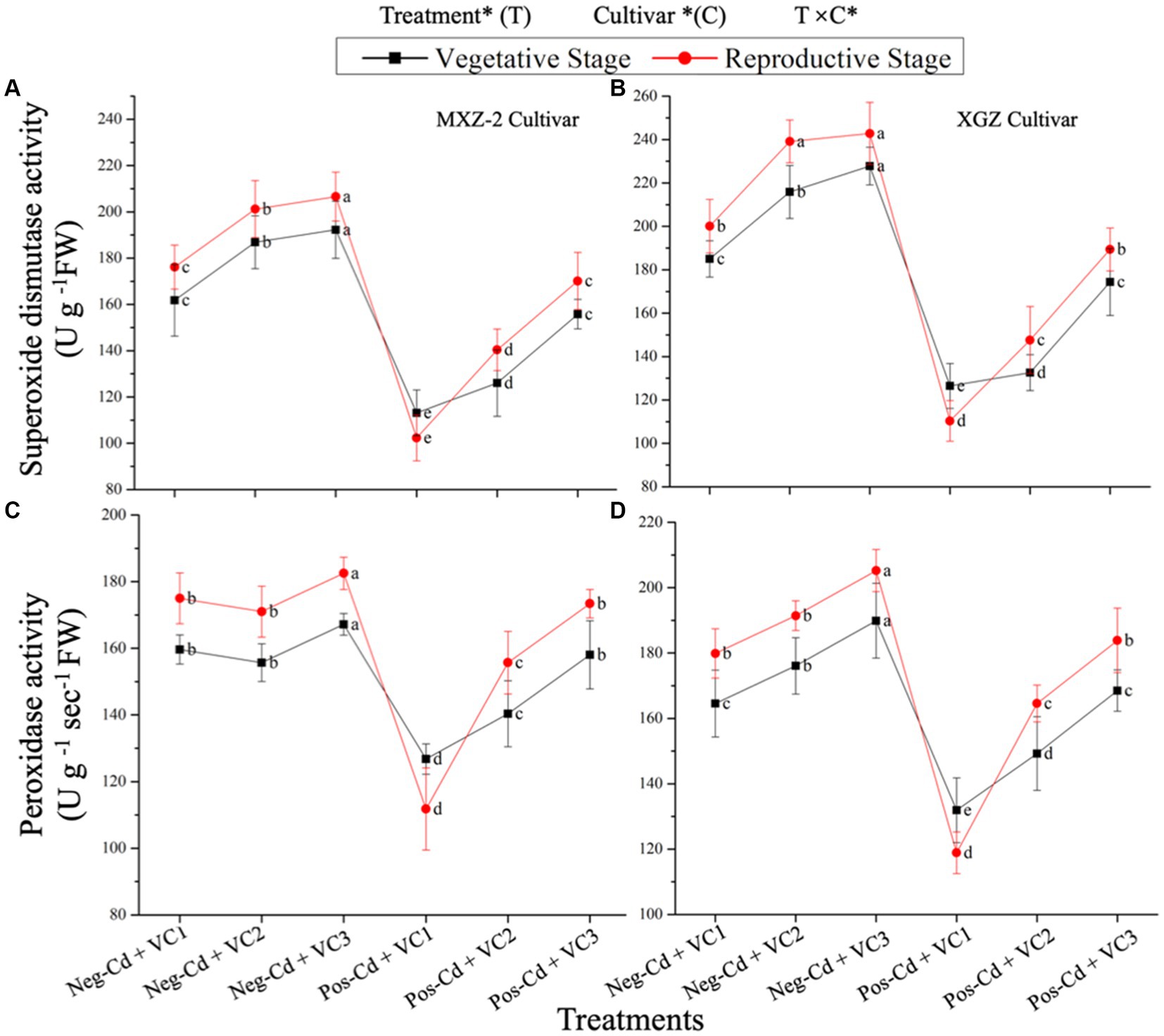
Figure 4. Effect of vermicompost application on the activity of superoxide dismutase (A,B) peroxidase (C,D) enzymes in the leaves of rice cultivars, i.e., MXZ-2 and XGZ at different growth periods under Cd toxicity conditions. Tukey analyses were performed to relate the means of the treatments, and the findings were interpreted based on the Tukey HSD test at (p < 0.05). Error bars are standard errors of the mean. At p < 0.05, bars with distinct letters show significant differences among the treatments. ** and * indicate significance level at 1% and 5%, respectively. See Table 1 for treatment combination details.
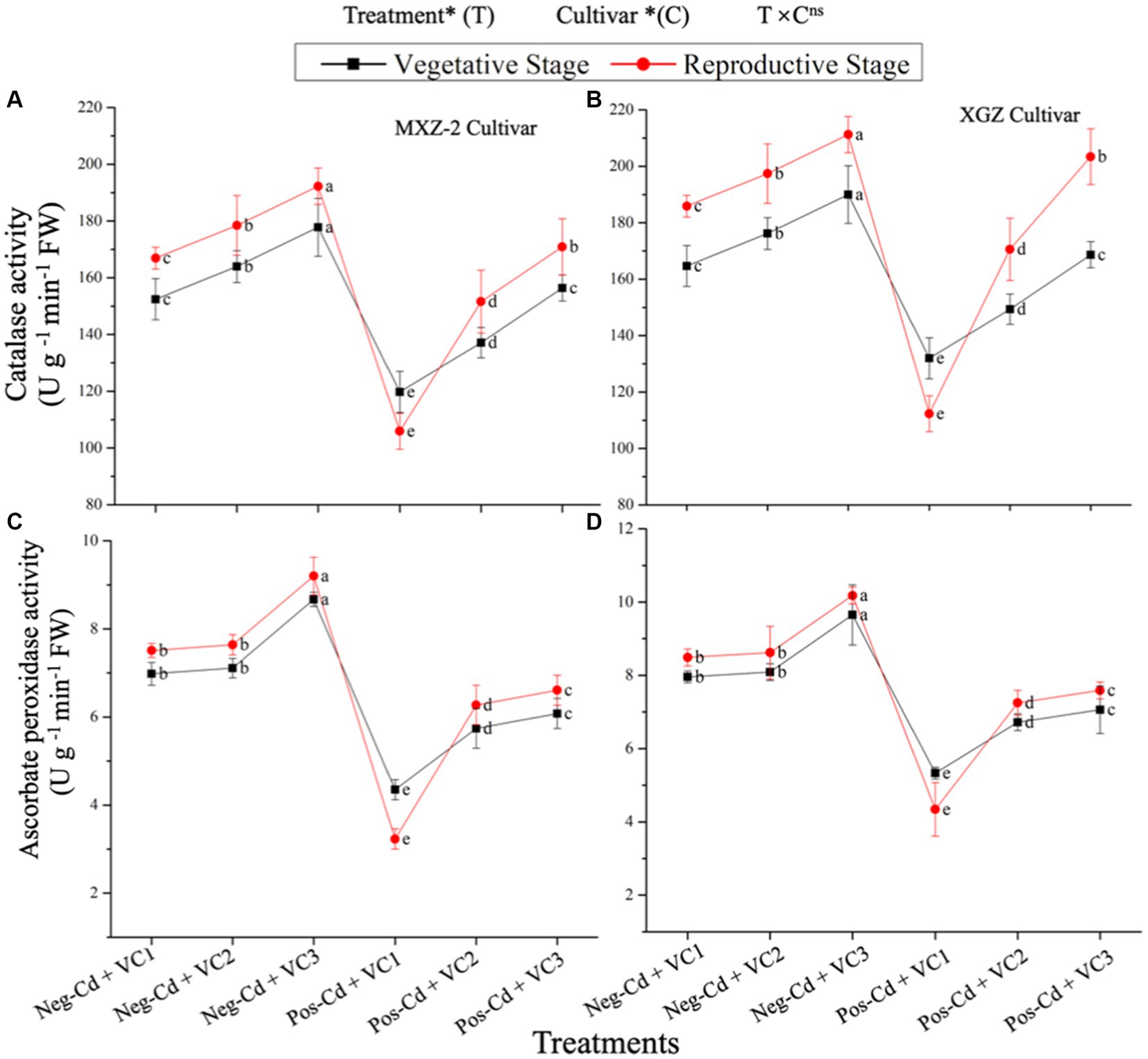
Figure 5. Effect of vermicompost application on the activity of catalase (A,B) and ascorbate peroxidase (C,D) enzymes of rice cultivars, i.e., MXZ-2 and XGZ at different growth periods. Tukey analyses were performed to relate the means of the treatments, and the findings were interpreted using a simple test based on the Tukey HSD test at (p < 0.05). Error bars are standard errors of the mean. At p < 0.05, bars with different letters show significant differences among the treatments. ** and * indicate significance at 1% and 5%, respectively. See Table 1 for treatment combination details.
3.5 Effect of VC application on the antioxidant genes expression pattern
In the current study, the expression patterns of antioxidant-related genes of both fragrant rice cultivars are shown in Figures 6, 7. The gene expression levels were altered by various VC treatments under Cd intoxication. In both cultivars, Cd-stressed plants had considerably lower expression patterns of genes (such as OsPOD, OsSOD, OsCAT, and OsAPX) than Neg-Cd plants. However, High-VC treatment reduced Cd toxicity in plants and elevated the pattern of genes related to the plant defense system. Pos-Cd + VC3 substantially enhanced transcript levels OsPOD (82.36 and 920.28%), OsSOD (88.68 and 68.65%), OsCAT (122.55 and 145.85%), and OsAPX (97.34 and 85.75%) in MXZ-2 and XGZ, relative to Pos-CD + VC1, averaged throughout development stages. Similarly, the other VC-treated plants showed significant increases in the transcription level of antioxidant-related genes.
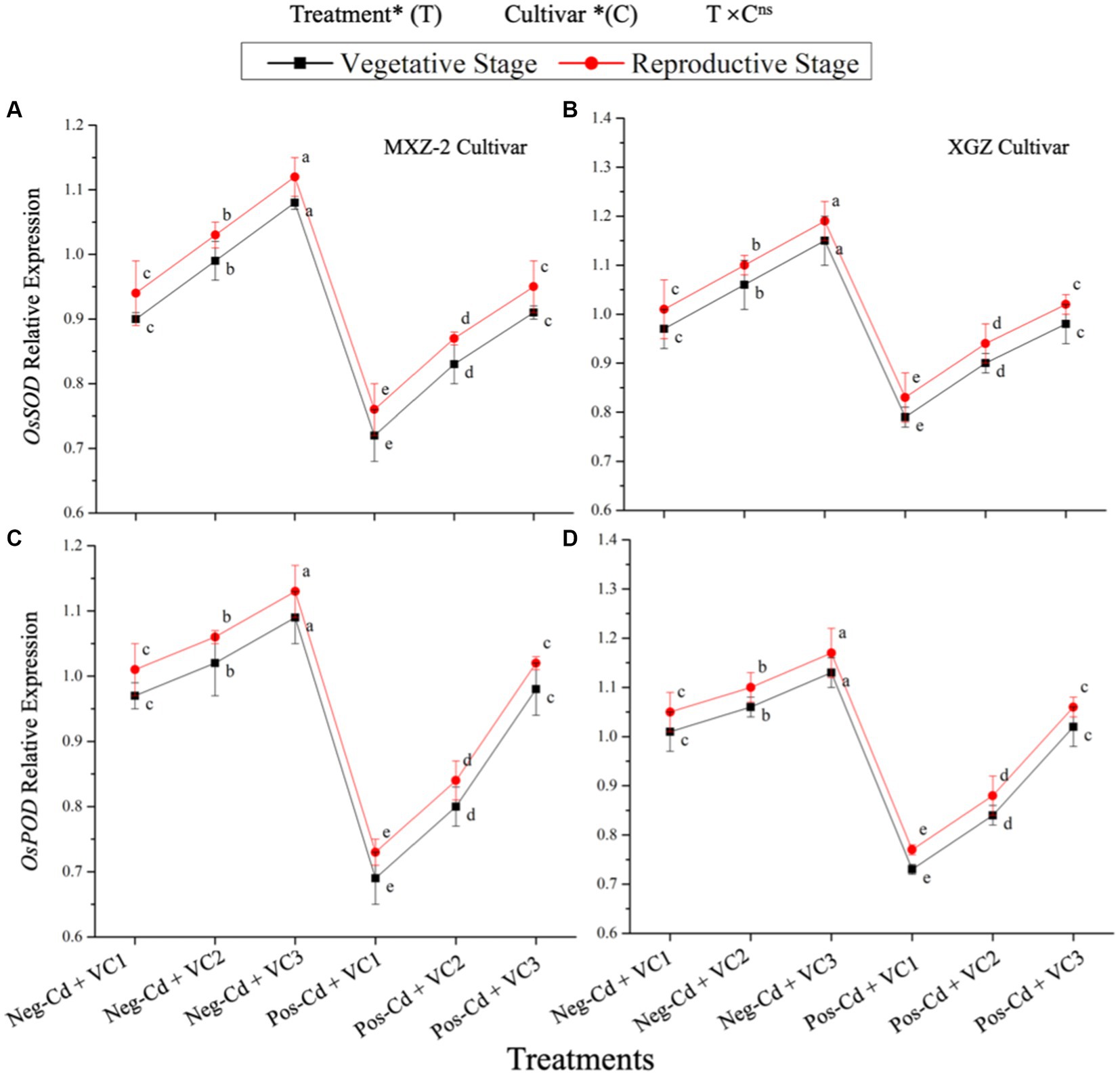
Figure 6. Effect of VC application on the relative expression of OsSOD (A,B) and OsPOD (C,D) of rice cultivars, i.e., MXZ-2 and XGZ at different growth stages. Tukey analyses were performed to relate the means of the treatments, and the findings were interpreted using a simple test based on the Tukey HSD test at (p < 0.05). Error bars are standard errors of the mean of the treatments. At p < 0.05, bars with distinct letter show significant differences among the treatments. ** and * indicate significance at 1% and 5%, respectively. See Table 1 for treatment combinations details.
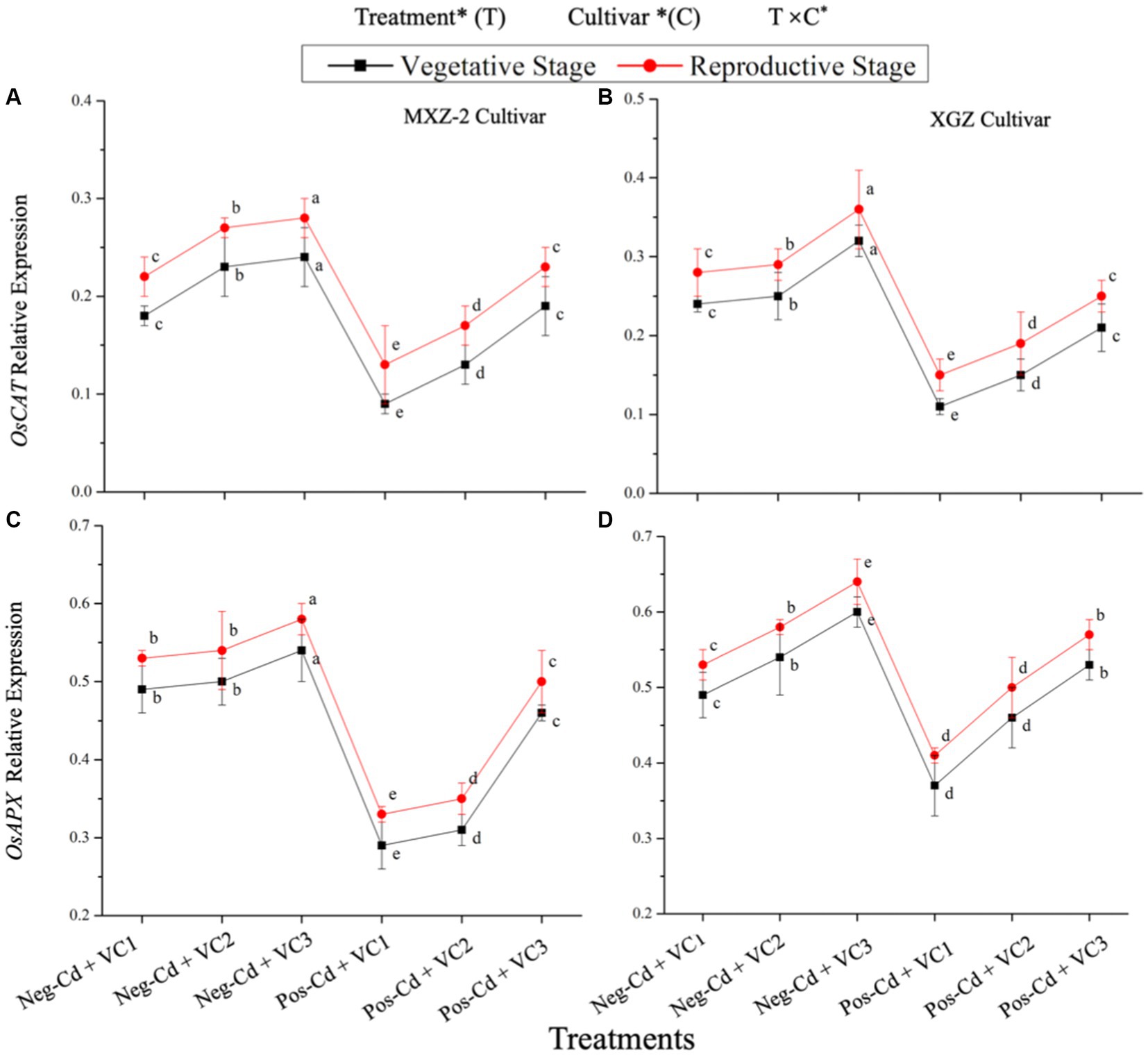
Figure 7. Effect of VC application on the relative expression of OsCAT (A,B) and OsAPX (C,D) of rice cultivars, i.e., MXZ-2 and XGZ at different growth periods. Tukey tests were performed to relate the means of the treatments, and the findings were interpreted using a simple test based on the Tukey HSD test at (p < 0.05). Error bars are standard errors of the mean. At p < 0.05, bars with distinct letter show significant (p < 0.05) differences among the treatments. ** and * indicate significance at 1% and 5%, respectively. See Table 1 for details treatment combinations.
3.6 Effect of VC application on protein and proline level
Soluble protein and proline production were significantly different with the use of VC under Cd toxicity (Table 2). Both cultivars had significant variations in protein and proline content. The results showed that the Cd toxicity significantly enhanced proline levels in both stages when compared to Neg-Cd experienced plants. However, the VC modifications reduced Cd stress and lowered proline synthesis. Proline production followed a consistent pattern across development stages, and when Pos-Cd + VC3 was applied, leaf proline concentration dropped by 65.44 and 55.44% in XGZ and MXZ-2 cultivars, correspondingly, compared to Pos-Cd plants. Likewise, lesser VC addition significantly reduced proline content when compared to Cd-stressed plants. In compared to proline, the Pos-Cd plants significantly reduced the soluble protein concentration. Soluble protein levels increased linearly from the vegetative to reproductive development phases. In comparison to Pos-Cd + VC1, Pos-Cd + VC3 treated pots increased leaf total protein content by 36.22 and 42.88% in XGZ and MXZ-2 cultivars, respectively (Table 2). Additionally, the results revealed that MXZ-2 had lower proline content and soluble protein than XGZ, suggesting that MXZ-2 is more vulnerable to stress conditions.
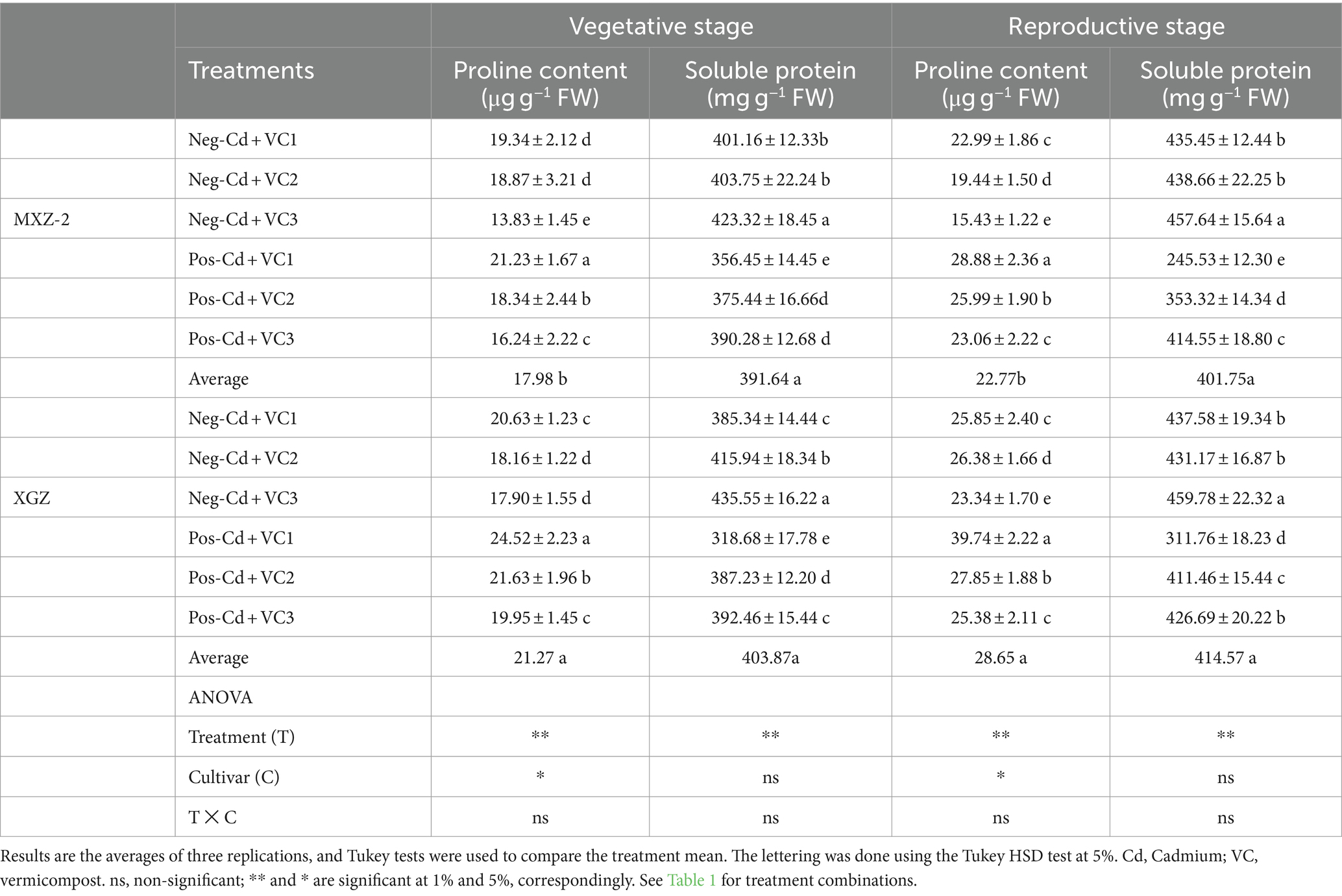
Table 2. Effect of VC application on proline and soluble protein content of different rice cultivars under Cd toxicity.
3.7 Influence of VC application on MDA and H2O2 contents under toxicity
The current findings showed that VC treatment considerably reduced the concentrations of MDA and H2O2 in both varieties under Cd conditions (Table 3). XGZ and MXZ-2 showed substantial (p < 0.05) variations for leaf MDA and H2O2 levels. In contrast, solo Cd-stressed plants significantly elevated MDA and H2O2 levels in both rice cultivars’ leaves. Sole Cd-stressed treatment (Pos-Cd + VC1) substantially raised the level of MDA by 68.42 and 82.66% and H2O2 by 72.66 and 82.34%, respectively, in XGZ and MXZ-2 cultivars (Table 3). Moreover, the outcomes revealed that the concentrations MDA and of H2O2 in MXZ-2 were greater than in XGZ, showing that the XGZ cultivar is more resistant to Cd pollution compared to MXZ.
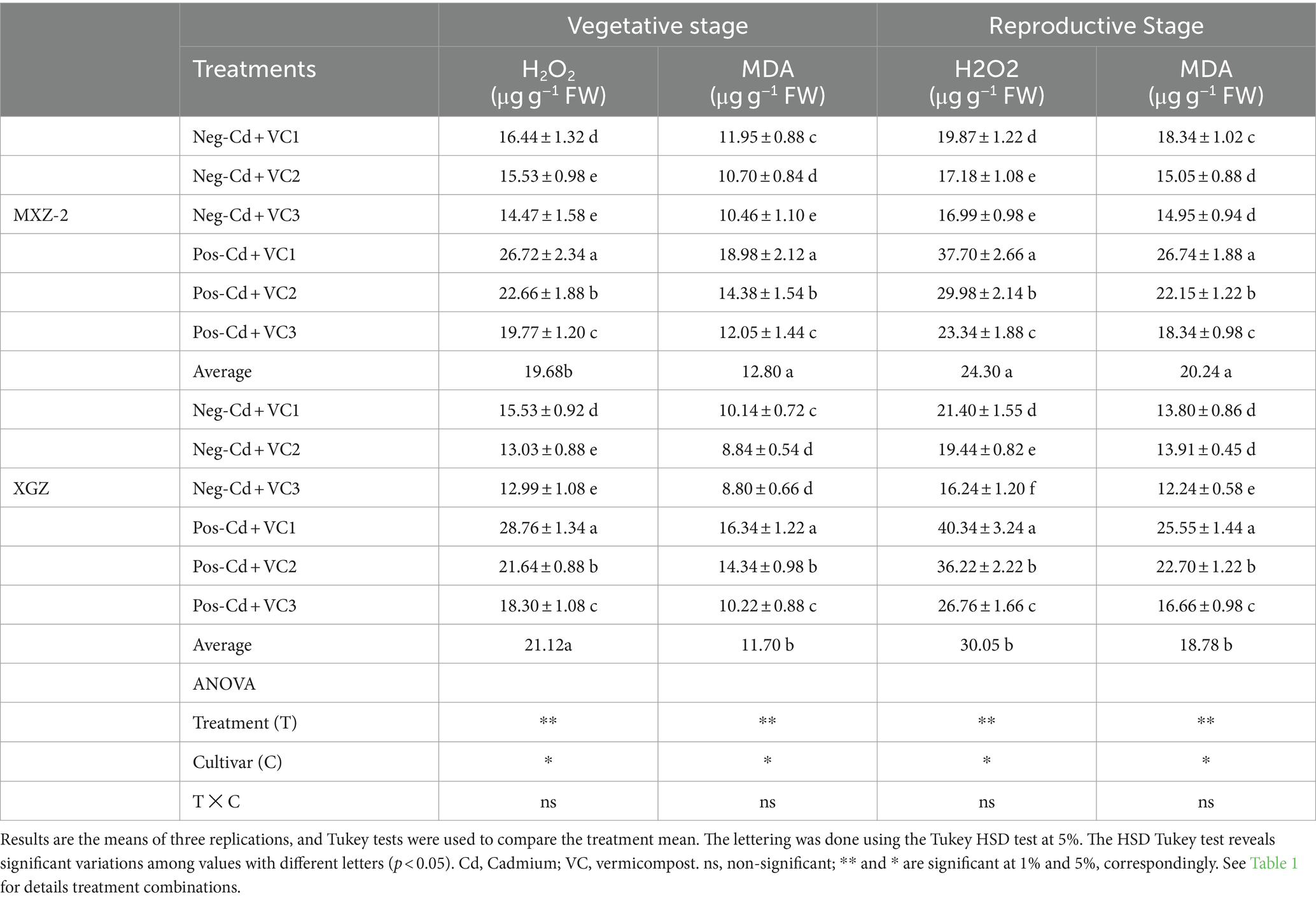
Table 3. Effect of VC application on H2O2 and MDA content of different fragrant rice cultivars (i.e., MXZ-2 and XGZ) under Cd toxicity.
3.8 Influence of VC amendments on Cd uptake in plant different organs and rice grain yield
The accumulation of Cd in several organs (root, stem + leaves, and grains) of both rice varieties is significantly (p < 0.05) higher in Cd stress plants (Table 4). However, the use of VC reduced Cd-related toxicity and significantly lowered Cd uptake in rice different organs. The Cd content in roots was higher than shoots and grains. Off the treatments, Neg-Cd + VC3 had the minimum Cd accumulation rice plant organs, whereas Pos-Cd + VC1 had the greatest levels. The use of VC significantly lowered Cd concentrations in roots, leaves, stems, and grain. Relative to Pos-Cd, the High VC (Pos-Cd + VC3) decreased the uptake of Cd in the MXZ-2 rice cultivar by 35.66, 46.65, and 73.55% in roots, shoots, and grains, respectively. Similarly, relative to Pos-Cd, the High-VC3 treatment reduced Cd absorption in XGZ cultivar by 33.45, 43.88, and 70.66% in roots, shoots, and grains, correspondingly. The data demonstrated that a high VC dosage significantly decreased Cd uptake in rice plants. Furthermore, the results showed that MXZ-2 accumulated more Cd than XGZ, implying that the aromatic rice XGZ is more resistant to Cd contamination soil than MXZ-2.
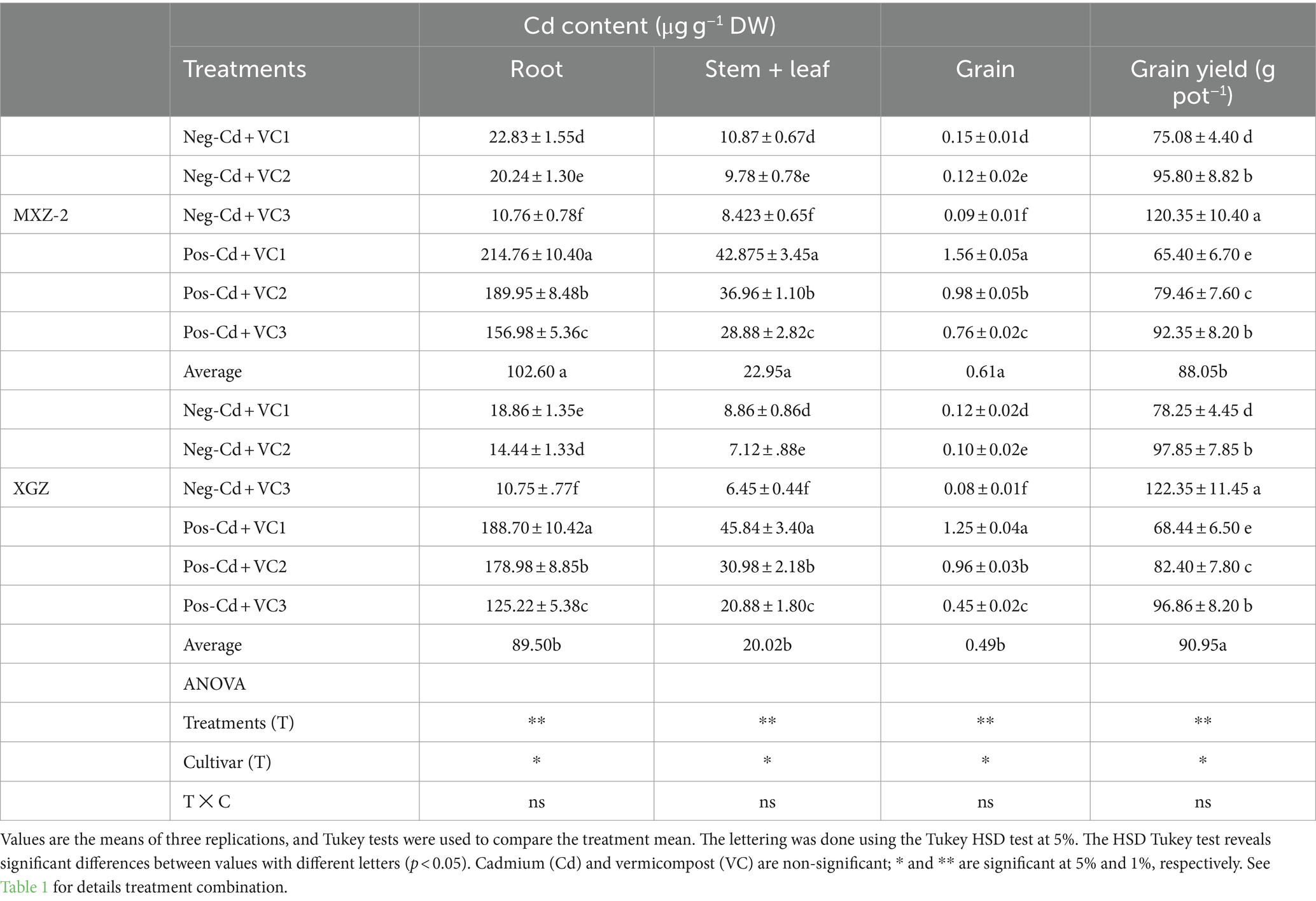
Table 4. The effect of VC uses on Cd accumulation in aromatic rice varieties in various organs and grain yield under Cd stress.
Additionally, the Cd stress reduced the fragrant rice yield and productivity. However, the VC application improved the rice yield and productivity; off the treatment, Neg-Cd + VC3 resulted in a higher rice grain yield. In addition, Pos-Cd + VC3 enhanced grain yield by 40.2% in MXZ-2 and 41.40% in the XGZ cultivar as compared to Pos-Cd + VC1 (Table 4). Similarly, low-VC-treated pots considerably improved the rice grain yield under Cd toxicity.
3.9 Relationship between soil properties, leaf net photosynthetic rate and antioxidant enzyme activity
A linear regression analysis were conducted to assess the role of soil quality in improving plant physiological activity and antioxidant defense system in the present study (Figure 8). A positive correlation was noted between the soil chemical traits, such as SOC and TN content with leaf net photosynthetic rate (Figures 8A,B). Furthermore, the correlation analysis showed that the SOC and TN were highly positively correlated with the net photosynthetic rate (R2 = 0.63*; Figure 8A) and (R2 = 0.60*; Figure 8B), respectively. The regression analysis exhibited that the improvements in leaf physiological activity are directly associated with soil quality, suggesting that higher soil health results in higher plant physiological activity. In addition, the correlation study among net photosynthetic levels and antioxidant enzyme activity also showed a highly positive correlation (Figure 9). The analysis showed that the photosynthetic rate was highly strongly correlated with the antioxidant enzyme activity (i.e., SOD; R2 = 0.84**; Figure 9A, POD; R2 = 0.92**; Figure 9B, CAT; R2 = 0.90**; Figure 9C, and APX; R2 = 0.80**; Figure 9D). These analyses displayed that the improvement in leaf physiological activity is directly related to plant antioxidant defense systems. Thus, the improvements in plant antioxidant systems and physiological performance are related to soil health and fertility.
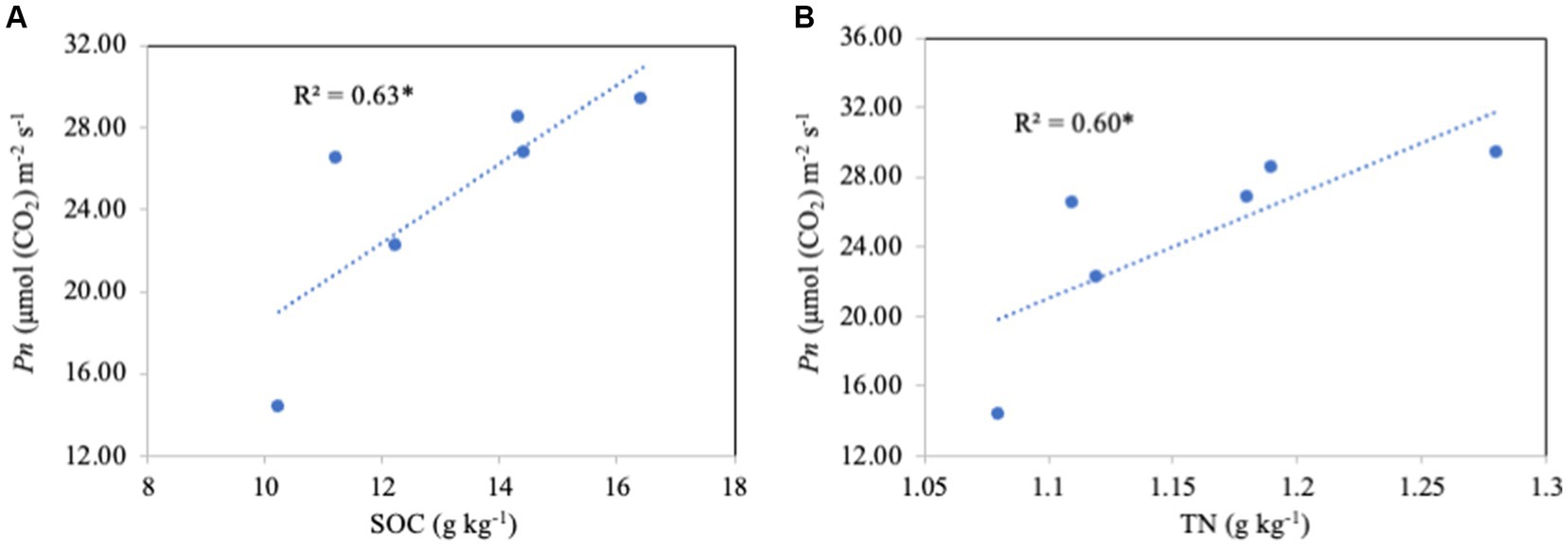
Figure 8. Linear regression analysis between soil organic carbon (SOC) and total nitrogen (TN) with leaf net photosynthetic rate (Pn) under VC application in a Cd-contaminated soil (n = 6). *P < 0.05.
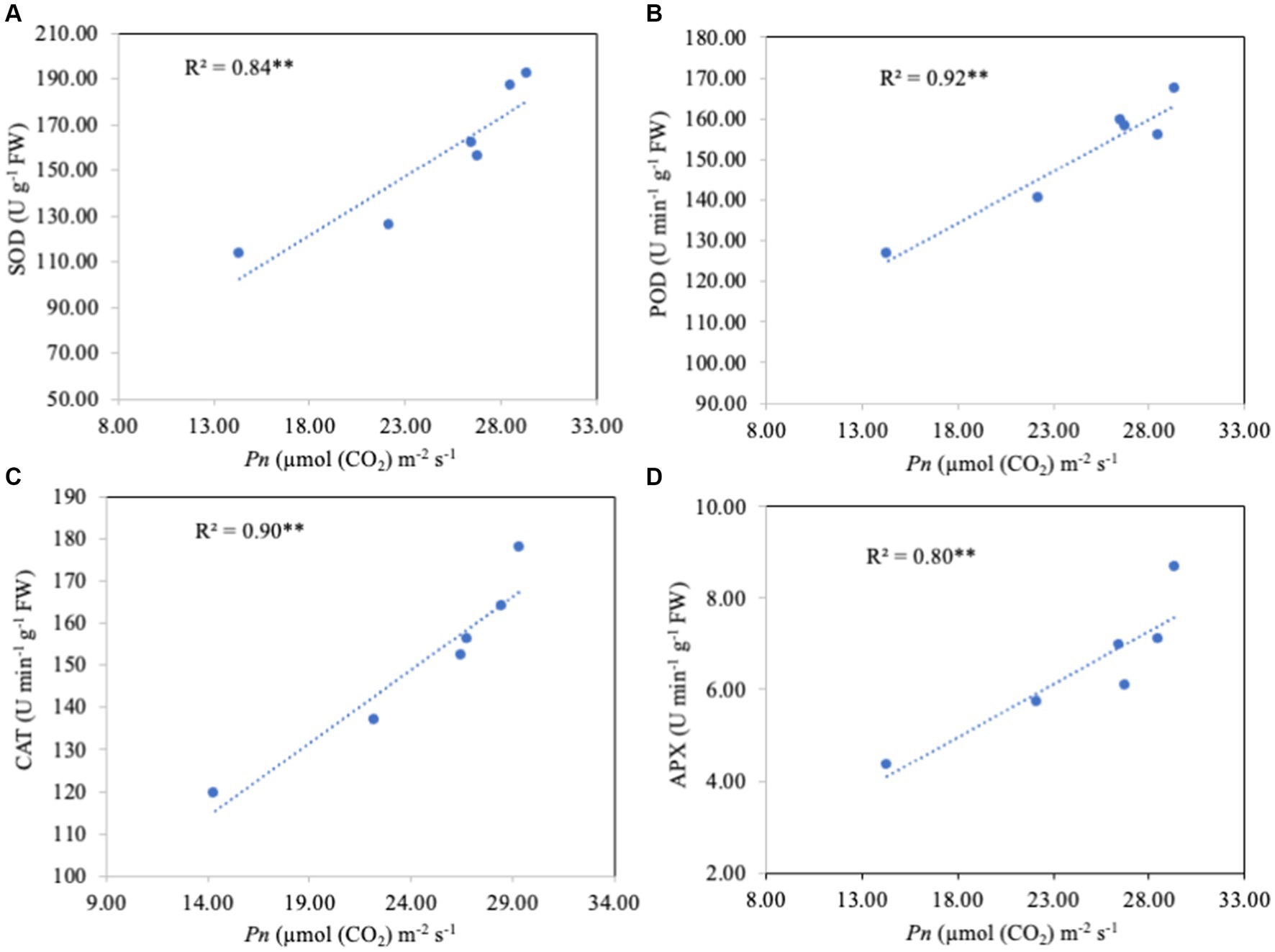
Figure 9. Linear regression analysis of leaf net photosynthetic rate (Pn) with antioxidant enzyme activity [i.e., SOD (A), POD (B), CAT (C), and APX (D)] under the application in a Cd-contaminated soil (n = 6). **P < 0.01.
4 Discussion
The physio-biochemical and antioxidant defense systems of plants are all disrupted by heavy metal pollution, particularly Cd toxicity. This results in significant yield reductions and losses in yield production and quality, which act as a serious risk to human health via the food chain (Liang et al., 2017). In situ stabilization, which involves immobilizing Cd through the application of organic fertilizers such as cattle dung, vermicompost, and biochar, is an effective and environmentally benign method recently (Ali et al., 2020; Hamid et al., 2020). In the present investigation, we examined how VC amendments affected the chemical properties of the paddy soil, the physio-biochemical features of the plants, the antioxidant defense systems, and the leaf ultrastructure of fragrant rice grown in soil contaminated with Cd.
4.1 Soil properties
According to Table 1 of this investigation, the use of VC greatly improved the soil qualitative characteristics under Cd toxicity. We noted that VC biodegrades improve soil quality and slowly release of plant-required nutrients throughout plant growth. The higher pH values were noted under VC amendments addition as compared to non-VC treated soil. According to Ni et al. (2018), nitrification generates H+ and lowers soil pH when synthetic N fertilizer is used only. The acidic characteristics of synthetic N may cooperate in reducing soil pH (Iqbal et al., 2019; Adekiya et al., 2020). On the other hand, soil acidity was greatly decreased by adding organic N additions (Iqbal et al., 2021a,b, 2023b). Likewise, in this study, the addition of VC significantly enhanced the pH of the soil (Table 1). This could be explained by the fact that the hydroxyl ions (OH−) from a-charged functional group in organic additions and the hydrolysis of CaCO3 produce hydroxyl ions (OH−) that interact with H+ ions to increase the pH of the soil. These hydroxyl ions include phenolic, hydroxyl, and carboxyl groups (Gul et al., 2015). Most growing plants would benefit from the pH of the soil being adjusted by the VC to a roughly neutral level (Fernández-Bayo et al., 2009).
Additionally, the addition of VC significantly improved the soil nutrient status in the present study. The possible explanation for this is the fact that the organic compost has a high ratio of organic matter and other essential plant nutrients (Tejada et al., 2010; Iqbal et al., 2023a,b). According to Liang et al. (2017), heavy metals typically do not melt or migrate readily in high-pH soil. Thus, it is possible that the higher soil pH caused by the application of VC fertilizer played an important role in slowing Cd migration in the soil in this experiment. Furthermore, the addition of VC improved soil nutrient availability, leading to greater plant growth and productivity in the current study (Table 1). The application of VC facilitates the secretion of mucus by earthworms, polysaccharides, and microorganisms, all of which improve the soil’s physical structure, which is important for plant root growth and nutrient uptake (Lim et al., 2015). In conclusion, vermicomposting enriches the soil with beneficial microbes, enzymes, and humic acids, hence improving soil structure and water retention capacity (Iqbal et al., 2023a). This increases nutrient availability to plants, allowing stronger root development and better nutrient uptake (Iqbal et al., 2024b). Furthermore, the VC addition enhances soil biodiversity by promoting the beneficial microbes which in turn enhances plant growth directly by production of plant growth-regulating hormones and enzymes and indirectly by controlling plant pathogens, nematodes, and other pests, thereby enhancing plant health and minimizing yield loss (Pathma and Sakthivel, 2012). Interestingly, its slow release of nutrients provides long-term fertility, decreasing the demand for artificial fertilizers and minimizing environmental effects (Pathma and Sakthivel, 2012). Overall, the use of VC improves soil fertility while also encouraging sustainable farming practices by promoting long-term soil health and productivity.
4.2 Leaf physiological and plant biochemical attributes
Photosynthesis is the main element of plant physiological activity and productivity by enhancing crop growth and biomass accumulation (Khan et al., 2017; Iqbal et al., 2020; Ali et al., 2021). In the present study, the VC enhanced the plant photosynthetic efficiency, including, Tr, gs, and Ci, in VC-treated plants as compared to non-VC-treated plants under Cd stress (Figures 1, 2). The enhancement in leaf photosynthetic activity induced under VC application could be primarily attributed to the improved soil fertility (Table 1), faster release of soil nutrients from VC in the early growth stages and gradual and slow release of crop-related nutrients from VC throughout the crop period (Yang et al., 2015; Luo H. et al., 2020; Luo Y. et al., 2020; Iqbal et al., 2022). Photosynthesis experienced a strong reaction to water and soil health (Makoto and Koike, 2007). A sufficient supply of water and nutrients will decrease the number of water-soluble nutrients and the stress-inducing root-sourced signal (ABA), which will open the stomata on leaves and increase their water potential and physiological activity (Daszkowska-Golec and Szarejko, 2013). In addition, the linear regression analysis in the present study also showed a highly positive relation between soil chemical traits and leaf photosynthetic activity (Figure 8). Aslam et al. (2020), reported that the application of VC improves the plant’s morphological and physiological attributes.
The VC addition enhances crop growth, yield, and quality due to its plant growth-promoting characteristics. VC stimulates plant emergence because of the availability of essential plant nutrients (Iqbal et al., 2024a,b). According to Khan et al. (2021), antioxidants can lessen oxidative damage and reactive oxidative stress in plants, which is important for plant defense systems. Under the Cd stress condition, the plant’s physiological and biochemical attributes significantly (p < 0.05) reduced in the current study (Figures 4, 5). Furthermore, the Cd toxicity damaged leaf ultrastructure components such as cell wall, chloroplast, and vacuoles (Figure 3). However, the VC addition counteracted the Cd toxicity and healed the plant’s oxidative damage, which may be linked to an increase in the activity of antioxidant enzymes and the expression of genes encoding antioxidants (Figures 4–7). According to earlier research, SOD, POD, CAT, and APX protected plants against oxidative plant damage by acting as antioxidant enzymes (Hasanuzzaman et al., 2020; Moustafa-Farag et al., 2020). In this study, we also found that pots containing Cd had lower SOD activity. This could be the case as SOD, which reduces reactive oxidative stress and transforms hazardous O2 into less toxic H2O2, is the antioxidant system’s first line of defense (Anjum et al., 2011). Similarly, a similar pattern was observed in the activity of CAT, which protects plant cells by turning O2 into the less toxic H2O2, thereby reducing oxidative stress (Sanchez-Casas and Klessig, 1994; Iqbal et al., 2023a,b). The procedure involved in eliminating O2 and the increased formation of H2O2 and MDA in the current investigation may be the cause of the significant decline in antioxidant enzyme activity under Cd stress (Table 3). On the other hand, both aromatic rice varieties’ antioxidant enzyme activity was enhanced by VC addition, which may have been a major factor in improving plant growth and antioxidant defense system. Moreover, the results of the linear regression analysis demonstrated that increased leaf physiological activity enhanced the antioxidant defense system and leaf ultrastructure, including the cell wall, chloroplast, and vacuole (Figures 3–5). Additionally, the expression level of antioxidants encoding genes is strongly elevated in plants treated with VC (Figures 6, 7). According to Gao et al. (2013), VC enhances the activity of antioxidant enzymes and so helps in the production of crops by shielding the leaf chloroplast structure from reactive O2.
Plant cytoplasm contains a substance called proline, which regulates osmotic pressure by altering the water potential of cells (Muneer et al., 2011). In this study, under Cd-stress situations, leaf proline content was boosted significantly (Table 2). Plant proline levels are elevated by heavy metal stress, especially Cd toxicity because stressed plants are more resilient (Bauddh and Singh, 2012). Plant protein degradation may be linked to an increase in proline content and plant damage may be reflected in an increase in proline levels in plant tissue (Palma et al., 2002). Our results are consistent with Elmer and White (2018) and Cao et al. (2014) who reported that the increased protease activity caused protein deficiency under Cd stress conditions. Similar findings were stated by other researchers that the production of soluble protein is significantly affected by stress conditions, particularly by Cd stress (Palma et al., 2002; Cao et al., 2014). However, the VC application alleviated the adverse effect of Cd on plants and greatly increased the protein content in the leaves of rice in the present study (Table 2). According to our findings, adding VC amendments to the soil improved its fertility, which in turn improved the physiological and biochemical processes of the plant by facilitating the uptake and accumulation of vital nutrients. Moreover, the VC application lowered the leaf proline content and strengthened plant defense systems due to improved plant physiological activity, indicating a moderating effect in preserving plant osmotic balance under Cd-contaminated soil (Table 2). The results of the linear regression analysis also demonstrated a strong and positive correlation between plant antioxidant defense systems and the leaf net photosynthetic rate (Figure 9).
The present research demonstrated that increased MDA and H2O2 generation were indicative of enhanced oxidative damage and leaf ultrastructure in the plant under Cd stress (Table 3). However, by lowering Cd uptake and aggregation in rice organs, VC treatments lessened the harmful effects of Cd (Table 4). Adding VC to soils not only gives plants vital nutrients for growth but also acts as a soil additive by causing heavy metals in the soil to become more complex, soluble, and precipitated. The VC reduces the mobility and uptake of Cd in plants (Huang et al., 2018). Therefore, by enhancing plant growth and antioxidant defense systems, the VC significantly decreased MDA and H2O2 in rice leaf organs. This suggests that the VC application lessened intracellular membrane disruptions caused by Cd throughout plant growth and development.
4.3 Cd accumulation in rice plant’s different organs and grain yield
In the current study, the use of VC dramatically decreased the absorption and content of Cd in rice in organs, including the roots, shoots, and grains (Table 4). The organic VC treatment, which reduced the accessibility and mobility of Cd in arable soil, is mostly responsible for this behavior. By enhancing the complexation and precipitation of metals in farming soil, VC addition can serve as a soil additive, giving plants nutrients and organic matter while simultaneously reducing their mobility and availability of heavy metals (Deng et al., 2017). However, VC amendments, because of its vast surface area, high cation exchange capacity, and richness in active functional groups, VC may be considered a promising treatment for stabilizing heavy metals in soil (Wang et al., 2018; Ding et al., 2021). When compared to soils that have not been treated with VC, the possibility of Cd absorption and uptake n in plant roots is therefore much decreased. Additionally, Wan et al. (2020) noted that supplying more organic fertilizers significantly decreased the amount of Cd in rice grain, ranging from 7.8 to 79.3%. In a similar vein, Tang et al. (2015) discovered that adding organic amendments decreased the amount of metal in B. chinezsis plant roots and shoots growing in acidic soil.
In the present study, the addition of VC significantly increased fragrant rice yields in Cd-stressed soil (Table 4). Improvements in crop production and quality are closely associated with enhancements in soil physiochemical and biological properties (Iqbal et al., 2021a,b). Organic fertilizers enhance soil health and fertility, which increases plant growth, crop yield, and yield elements (Ali et al., 2020; Iqbal et al., 2022). In this study, increased soil nutritional values were found in VC-treated soil (Table 1), which improved aromatic rice growth, physiological activity, and yield by giving the necessary nutrients across the growing period. This was supported by linear regression, which revealed that soil chemical features were highly positively related to leaf physiological traits (Figure 8). Iqbal et al. (2022) found that differences in yield are positively linked with soil biochemical state. Thus, variations in rice yield and yield components are largely dependent on soil health and nutrition.
5 Conclusion
This study aimed to determine how VC application reduced the adverse impacts of Cd toxicity on soil health and fragrant rice growth and grain yield. The results showed that the soil quality and physiological and metabolic efficiency of the fragrant rice cultivars were adversely affected by Cd toxicity. Moreover, under Cd stress, there was an increase in proline, MDA, and H2O2 production, as well as Cd uptake and accumulation in rice organs, particularly in the roots and leaves. However, the VC application alleviated the Cd toxicity on soil health and plant physiological and biochemical attributes. The application of VC simultaneously immobilized Cd in paddy soil and enhanced the chemical characteristics of the soil due to its vast surface area, high cation exchange capacity, and richness in active functional groups and nutrients. Our findings concluded that the addition of VC enhances plant growth and production by promoting soil fertility which in turn enhances plant nutrient uptake and reduces Cd toxicity. Overall, the use of VC improves soil fertility while also encouraging sustainable farming practices by decreasing the demand for synthetic fertilizers and promoting long-term soil health and crop productivity.
Data availability statement
The original contributions presented in the study are included in the article/Supplementary material, further inquiries can be directed to the corresponding authors.
Author contributions
AI: Conceptualization, Methodology, Project administration, Supervision, Visualization, Data curation, Formal analysis, Investigation, Software, Writing – original draft. RK: Methodology, Formal analysis, Software, Validation, Visualization, Writing - review & editing. QH: Formal analysis, Methodology, Software, Validation, Writing – review & editing, Conceptualization, Data curation, Investigation, Visualization. MI: Methodology, Formal analysis, Software, Validation, Visualization, Resources, Writing - review & editing. ZM: Conceptualization, Data curation, Investigation, Methodology, Software, Writing – review & editing, Project administration, Resources, Supervision. TH: Data curation, Formal analysis, Methodology, Software, Supervision, Visualization, Writing – review & editing, Project administration, Resources. MA: Conceptualization, Formal analysis, Methodology, Software, Supervision, Writing – review & editing, Data curation, Visualization. IA: Formal analysis, Funding acquisition, Methodology, Resources, Software, Supervision, Validation, Writing – review & editing. HR: Funding acquisition, Methodology, Supervision, Writing – review & editing, Conceptualization, Formal analysis, Project administration, Software. MS: Conceptualization, Methodology, Project administration, Supervision, Validation, Writing – review & editing, Formal analysis, Funding acquisition, Resources, Software, Visualization. AE: Writing – review & editing, Funding acquisition, Methodology, Resources, Supervision, Validation. RL: Conceptualization, Methodology, Project administration, Supervision, Validation, Writing – review & editing. XT: Writing – review & editing.
Funding
The author(s) declare that financial support was received for the research, authorship, and/or publication of this article. Our work was supported by the Guangzhou Science and Technology Project (202103000075) and the Talent Introduction and Research Program of South China Agriculture University (41000-222106).
Acknowledgments
The authors extended their appreciation to the Researcher Supporting Project Number (RSPD2024R745), King Saud University, Riyadh, Saudi Arabia. In addition, we want to thank our South China Agriculture University Research Station collaborators for their research assistance.
Conflict of interest
The authors declare that the research was conducted in the absence of any commercial or financial relationships that could be construed as a potential conflict of interest.
Publisher’s note
All claims expressed in this article are solely those of the authors and do not necessarily represent those of their affiliated organizations, or those of the publisher, the editors and the reviewers. Any product that may be evaluated in this article, or claim that may be made by its manufacturer, is not guaranteed or endorsed by the publisher.
Supplementary material
The Supplementary material for this article can be found online at: https://www.frontiersin.org/articles/10.3389/fsufs.2024.1418554/full#supplementary-material
References
Adekiya, A. O., Agbede, T. M., Ejue, W. S., Aboyeji, C. M., Dunsin, O., Aremu, C. O., et al. (2020). Biochar, poultry manure and NPK fertilizer: sole and combine application effects on soil properties and ginger (Zingiber officinale roscoe) performance in a tropical Alfisol. Open Agricult. 5, 30–39. doi: 10.1515/opag-2020-0004
Adil, M. F., Sehar, S., Chen, G., Chen, Z. H., Jilani, G., Chaudhry, A. N., et al. (2020). Cadmium-zinc crosstalk delineates toxicity tolerance in rice via differential genes expression and physiological/ultrastructural adjustments. Ecotoxicol. Environ. Saf. 190:110076. doi: 10.1016/j.ecoenv.2019.110076
Adil, M. F., Sehar, S., Ma, Z., Tahira, K., Askri, S. M. H., el-Sheikh, M. A., et al. (2024). Insights into the alleviation of cadmium toxicity in rice by nano-zinc and Serendipita indica: modulation of stress-responsive gene expression and antioxidant defense system activation. Environ. Pollut. 350:123952. doi: 10.1016/j.envpol.2024.123952
Alam, M., Hussain, Z., Khan, A., Khan, M. A., Rab, A., Asif, M., et al. (2020). The effects of organic amendments on heavy metals bioavailability in mine impacted soil and associated human health risk. Sci. Hortic. 262:109067. doi: 10.1016/j.scienta.2019.109067
Ali, I., Adnan, M., Ullah, S., Zhao, Q., Iqbal, A., He, L., et al. (2022a). Biochar combined with nitrogen fertilizer: a practical approach for increasing the biomass digestibility and yield of rice and promoting food and energy security. Biofuels Bioprod. Biorefin. 16, 1304–1318. doi: 10.1002/bbb.2334
Ali, I., Iqbal, A., Ullah, S., Muhammad, I., Yuan, P., Zhao, Q., et al. (2022b). Effects of biochar amendment and nitrogen fertilizer on RVA profile and rice grain quality attributes. Food Secur. 11:625. doi: 10.3390/foods11050625
Ali, I., Ullah, S., He, L., Zhao, Q., Iqbal, A., Wei, S., et al. (2020). Combined application of biochar and nitrogen fertilizer improves rice yield, microbial activity and N-metabolism in a pot experiment. PeerJ 8:e10311. doi: 10.7717/peerj.10311
Ali, I., Yuan, P., Ullah, S., Iqbal, A., Zhao, Q., Liang, H., et al. (2022c). Biochar amendment and nitrogen fertilizer contribute to the changes in soil properties and microbial communities in a paddy field. Front. Microbiol. 13:834751. doi: 10.3389/fmicb.2022.834751
Ali, I., Zhao, Q., Wu, K., Ullah, S., Iqbal, A., Liang, H., et al. (2021). Biochar in combination with nitrogen fertilizer is a technique: to enhance physiological and morphological traits of Rice (Oryza sativa L.) by improving soil physio-biochemical properties. J. Plant Growth Regul. 41, 2406–2420. doi: 10.1007/s00344-021-10454-8
Aslam, Z., Ahmad, A., Bellitürk, K., Iqbal, N., Idrees, M., Ur Rehman, W., et al. (2020). Effects of vermicompost, vermi-tea and chemical fertilizer on morpho-physiological characteristics of tomato (Solanum lycopersicum) in Suleymanpasa District, Tekirdag of Turkey. Pure Appl. Biol. 9, 1920–1931. doi: 10.19045/bspab.2020.90205
Anjum, N., Umar, S., Iqbal, M., and Khan, N. (2011). Cadmium causes oxidative stress in mung bean by affecting the antioxidant enzyme system and ascorbate-glutathione cycle metabolism. Russ. J. Plant Physiol, 58:92–99.
Bari, M. A., Akther, M. S., Reza, M. A., and Kabir, A. H. (2019). Cadmium tolerance is associated with the root-driven coordination of cadmium sequestration, iron regulation, and ROS scavenging in rice. Plant Physiol. Biochem. 136, 22–33. doi: 10.1016/j.plaphy.2019.01.007
Bates, L. S., Waldren, R. A., and Teare, I. D. (1973). Rapid determination of free proline for water-stress studies. Plant Soil 39, 205–207. doi: 10.1007/BF00018060
Bauddh, K., and Singh, R. P. (2012). Growth, tolerance efficiency and phytoremediation potential of Ricinus communis (L.) and Brassica juncea (L.) in salinity and drought affected cadmium contaminated soil. Ecotoxicol. Environ. Saf. 85, 13–22. doi: 10.1016/j.ecoenv.2012.08.019
Bin Rahman, A. R., and Zhang, J. (2023). Trends in rice research: 2030 and beyond. Food Energy Secur. 12:e390. doi: 10.1002/fes3.390
Bradford, M. M. (1976). A rapid and sensitive method for the quantitation of microgram quantities of protein utilizing the principle of protein-dye binding. Anal. Biochem. 72, 248–254. doi: 10.1016/0003-2697(76)90527-3
Bradham, K. D., Diamond, G. L., Nelson, C. M., Noerpel, M., Scheckel, K. G., Elek, B., et al. (2018). Long-term in situ reduction in soil lead bioavailability measured in a mouse model. Environ. Sci. Technol. 52, 13908–13913. doi: 10.1021/acs.est.8b04684
Cambier, P., Michaud, A., Paradelo, R., Germain, M., Mercier, V., Guérin-Lebourg, A., et al. (2019). Trace metal availability in soil horizons amended with various urban waste composts during 17 years–monitoring and modelling. Sci. Total Environ. 651, 2961–2974. doi: 10.1016/j.scitotenv.2018.10.013
Cao, F., Wang, R., Cheng, W., Zeng, F., Ahmed, I. M., Hu, X., et al. (2014). Genotypic and environmental variation in cadmium, chromium, lead and copper in rice and approaches for reducing the accumulation. Sci. Total Environ. 496, 275–281. doi: 10.1016/j.scitotenv.2014.07.064
Charan, K., Bhattacharyya, P., and Bhattacharya, S. S. (2024). Vermitechnology transforms hazardous red mud into benign organic input for agriculture: insights on earthworm-microbe interaction, metal removal, and soil-crop improvement. J. Environ. Manag. 354:120320. doi: 10.1016/j.jenvman.2024.120320
Chauhan, B. S., Jabran, K., and Mahajan, G. (2017). Rice production worldwide. Berlin, Heidelberg: Springer.
Chen, Y., Jiang, Y., Huang, H., Mou, L., Ru, J., Zhao, J., et al. (2018). Long-term and high-concentration heavy-metal contamination strongly influences the microbiome and functional genes in Yellow River sediments. Sci. Total Environ. 637-638, 1400–1412. doi: 10.1016/j.scitotenv.2018.05.109
Chen, Q., Lu, X., Guo, X., Pan, Y., Yu, B., Tang, Z., et al. (2018). Differential responses to cd stress induced by exogenous application of cu, Zn or ca in the medicinal plant Catharanthus roseus. Ecotoxicol. Environ. Saf. 157, 266–275. doi: 10.1016/j.ecoenv.2018.03.055
Dabral, S., Varma, A., Choudhary, D. K., Bahuguna, R. N., and Nath, M. (2019). Biopriming with Piriformospora indica ameliorates cadmium stress in rice by lowering oxidative stress and cell death in root cells. Ecotoxicol. Environ. Saf. 186:109741. doi: 10.1016/j.ecoenv.2019.109741
Daszkowska-Golec, A., and Szarejko, I. (2013). Open or close the gate–stomata action under the control of phytohormones in drought stress conditions. Front. Plant Sci. 4:138. doi: 10.3389/fpls.2013.00138
Deng, X., Wu, C., Li, Q., and Li, W., (2017). Effect of vermicompost on soil enzyme activity of coastal saline soil in water spinach plantation. In 2017 6th international conference on energy, environment and sustainable development (ICEESD 2017), 419–422). Atlantis Press.
Ding, Z., Kheir, A. M., Ali, O. A., Hafez, E. M., ElShamey, E. A., Zhou, Z., et al. (2021). A vermicompost and deep tillage system to improve saline-sodic soil quality and wheat productivity. J. Environ. Manag. 277:111388. doi: 10.1016/j.jenvman.2020.111388
Dubey, R. K., Dubey, P. K., Chaurasia, R., Singh, H. B., and Abhilash, P. C. (2020). Sustainable agronomic practices for enhancing the soil quality and yield of Cicer arietinum L. under diverse agroecosystems. J. Environ. Manag. 262:110284. doi: 10.1016/j.jenvman.2020.110284
Elmer, W., and White, J. C. (2018). The future of nanotechnology in plant pathology. Annu. Rev. Phytopathol. 56, 111–133. doi: 10.1146/annurev-phyto-080417-050108
Fernández-Bayo, J. D., Nogales, R., and Romero, E. (2009). Assessment of three vermicomposts as organic amendments used to enhance diuron sorption in soils with low organic carbon content. Eur. J. Soil Sci. 60, 935–944. doi: 10.1111/j.1365-2389.2009.01176.x
Gallego, S. M., Pena, L. B., Barcia, R. A., Azpilicueta, C. E., Iannone, M. F., Rosales, E. P., et al. (2012). Unravelling cadmium toxicity and tolerance in plants: insight into regulatory mechanisms. Environ. Exp. Bot. 83, 33–46. doi: 10.1016/j.envexpbot.2012.04.006
Gao, J., Xu, G., Qian, H., Liu, P., Zhao, P., and Hu, Y. (2013). Effects of nano-TiO2 on photosynthetic characteristics of Ulmus elongata seedlings. Environ. Pollut. 176, 63–70. doi: 10.1016/j.envpol.2013.01.027
Goswami, L., Ekblad, A., Choudhury, R., and Bhattacharya, S. S. (2024). Vermi-converted tea industry coal ash efficiently substitutes chemical fertilization for growth and yield of cabbage (Brassica oleracea var. capitata) in an alluvial soil: a field-based study on soil quality, nutrient translocation, and metal-risk remediation. Sci. Total Environ. 907:168088. doi: 10.1016/j.scitotenv.2023.168088
Gu, J. F., Zhou, H., Tang, H. L., Yang, W. T., Zeng, M., Liu, Z. M., et al. (2019). Cadmium and arsenic accumulation during the rice growth period under in situ remediation. Ecotoxicol. Environ. Saf. 171, 451–459. doi: 10.1016/j.ecoenv.2019.01.003
Gul, S., Whalen, J. K., Thomas, B. W., Sachdeva, V., and Deng, H. (2015). Physico-chemical properties and microbial responses in biochar-amended soils: mechanisms and future directions. Agric. Ecosyst. Environ. 206, 46–59. doi: 10.1016/j.agee.2015.03.015
Haider, F. U., Liqun, C., Coulter, J. A., Cheema, S. A., Wu, J., Zhang, R., et al. (2021). Cadmium toxicity in plants: impacts and remediation strategies. Ecotoxicol. Environ. Saf. 211:111887. doi: 10.1016/j.ecoenv.2020.111887
Hamid, Y., Tang, L., Hussain, B., Usman, M., Lin, Q., Rashid, M. S., et al. (2020). Organic soil additives for the remediation of cadmium contaminated soils and their impact on the soil-plant system: a review. Sci. Total Environ. 707:136121. doi: 10.1016/j.scitotenv.2019.136121
Hasanuzzaman, M., Bhuyan, M. B., Zulfiqar, F., Raza, A., Mohsin, S. M., Mahmud, J. A., et al. (2020). Reactive oxygen species and antioxidant defense in plants under abiotic stress: revisiting the crucial role of a universal defense regulator. Antioxidants 9:681. doi: 10.3390/antiox9080681
Huang, Y., Wang, L., Wang, W., Li, T., He, Z., and Yang, X. (2019). Current status of agricultural soil pollution by heavy metals in China: a meta-analysis. Sci. Total Environ. 651, 3034–3042. doi: 10.1016/j.scitotenv.2018.10.185
Huang, L. M., Yu, G. W., Zou, F. Z., Long, X. X., and Wu, Q. T. (2018). Shift of soil bacterial community and decrease of metals bioavailability after immobilization of a multi-metal contaminated acidic soil by inorganic-organic mixed amendments: a field study. Appl. Soil Ecol. 130, 104–119. doi: 10.1016/j.apsoil.2018.05.014
Hussain, N., Chatterjee, S. K., Maiti, T. K., Goswami, L., das, S., Deb, U., et al. (2021). Metal induced non-metallothionein protein in earthworm: a new pathway for cadmium detoxification in chloragogenous tissue. J. Hazard. Mater. 401:123357. doi: 10.1016/j.jhazmat.2020.123357
Huybrechts, M., Hendrix, S., Bertels, J., Beemster, G. T., Vandamme, D., and Cuypers, A. (2020). Spatial analysis of the rice leaf growth zone under controlled and cadmium-exposed conditions. Environ. Exp. Bot. 177:104120. doi: 10.1016/j.envexpbot.2020.104120
Igalavithana, A. D., Park, J., Ryu, C., Lee, Y. H., Hashimoto, Y., Huang, L., et al. (2017). Slow pyrolyzed biochars from crop residues for soil metal (loid) immobilization and microbial community abundance in contaminated agricultural soils. Chemosphere 177, 157–166. doi: 10.1016/j.chemosphere.2017.02.112
Imran, M., Hussain, S., el-Esawi, M. A., Rana, M. S., Saleem, M. H., Riaz, M., et al. (2020). Molybdenum supply alleviates the cadmium toxicity in fragrant rice by modulating oxidative stress and antioxidant gene expression. Biomol. Ther. 10:1582. doi: 10.3390/biom10111582
Iqbal, A., Ali, I., Yuan, P., Khan, R., Liang, H., Wei, S., et al. (2022). Combined application of manure and chemical fertilizers alters soil environmental variables and improves soil fungal community composition and rice grain yield. Front. Microbiol. 13:856355. doi: 10.3389/fmicb.2022.856355
Iqbal, A., He, L., Ali, I., Ullah, S., Khan, A., Khan, A., et al. (2020). Manure combined with chemical fertilizer increases rice productivity by improving soil health, post-anthesis biomass yield, and nitrogen metabolism. PLoS One 15:e0238934. doi: 10.1371/journal.pone.0238934
Iqbal, A., He, L., Khan, A., Wei, S., Akhtar, K., Ali, I., et al. (2019). Organic manure coupled with inorganic fertilizer: an approach for the sustainable production of rice by improving soil properties and nitrogen use efficiency. Agronomy 9:651. doi: 10.3390/agronomy9100651
Iqbal, A., He, L., McBride, S. G., Ali, I., Akhtar, K., Khan, R., et al. (2021a). Manure applications combined with chemical fertilizer improves soil functionality. Microbial biomass and rice production in a paddy field. Agro 114, 1431–1446. doi: 10.1002/agj2.20990
Iqbal, A., Hussain, Q., Mo, Z., Hua, T., Mustafa, A. E. Z. M., and Tang, X. (2024a). Vermicompost supply enhances fragrant-Rice yield by improving soil fertility and eukaryotic microbial community composition under environmental stress conditions. Microorganisms 12:1252. doi: 10.3390/microorganisms12061252
Iqbal, A., Khan, A., Green, S. J., Ali, I., He, L., Zeeshan, M., et al. (2021b). Long-term straw mulching in a no-till field improves soil functionality and rice yield by increasing soil enzymatic activity and chemical properties in paddy soils. J. Plant Nutr. Soil Sci. 184, 622–634. doi: 10.1002/jpln.202100089
Iqbal, A., Ligeng, J., Mo, Z., Adnan, M., Lal, R., Zaman, M., et al. (2024b). Substation of vermicompost mitigates cd toxicity, improves rice yields and restores bacterial community in a cd-contaminated soil in southern China. J. Hazard. Mater. 465:133118. doi: 10.1016/j.jhazmat.2023.133118
Iqbal, A., Mo, Z., Pan, S. G., Qi, J. Y., Hua, T., Imran, M., et al. (2023a). Exogenous TiO2 nanoparticles alleviate cd toxicity by reducing cd uptake and regulating plant physiological activity and antioxidant defense Systems in Rice (Oryza sativa L.). Meta 13:765. doi: 10.3390/metabo13060765
Iqbal, A., Tang, X., Ali, I., Yuan, P., Khan, R., Khan, Z., et al. (2023b). Integrating low levels of organic fertilizer improves soil fertility and rice yields in paddy fields by influencing microbial communities without increasing CH4 emissions. Appl. Soil Ecol. 189:104951. doi: 10.1016/j.apsoil.2023.104951
Islam, M. N., Taki, G., Nguyen, X. P., Jo, Y. T., Kim, J., and Park, J. H. (2017). Heavy metal stabilization in contaminated soil by treatment with calcined cockle shell. Environ. Sci. Pollut. Res. 24, 7177–7183. doi: 10.1007/s11356-016-8330-5
Jackson, M. L. (1956). Soil chemical analysis-advanced course, published by the author. Wisconsin: Madison, 991.
Jiang, M., and Zhang, J. (2001). Effect of abscisic acid on active oxygen species, antioxidative defence system and oxidative damage in leaves of maize seedlings. Plant Cell Physiol. 42, 1265–1273. doi: 10.1093/pcp/pce162
Khan, M. N., Li, Y., Khan, Z., Chen, L., Liu, J., Hu, J., et al. (2021). Nanoceria seed priming enhanced salt tolerance in rapeseed through modulating ROS homeostasis and α-amylase activities. J. Nanobiotechnol. 19, 1–19. doi: 10.1186/s12951-021-01026-9
Khan, A., Najeeb, U., Wang, L., Tan, D. K. Y., Yang, G., Munsif, F., et al. (2017). Planting density and sowing date strongly influence growth and lint yield of cotton crops. Field Crop Res. 209, 129–135. doi: 10.1016/j.fcr.2017.04.019
Khan, S., Sehar, Z., Fatma, M., Mir, I. R., Iqbal, N., Tarighat, M. A., et al. (2022). Involvement of ethylene in melatonin-modified photosynthetic-N use efficiency and antioxidant activity to improve photosynthesis of salt grown wheat. Physiol. Plant. 174:e13832. doi: 10.1111/ppl.13832
Liang, L., Liu, W., Sun, Y., Huo, X., Li, S., and Zhou, Q. (2017). Phytoremediation of heavy metal contaminated saline soils using halophytes: current progress and future perspectives. Environ. Rev. 25, 269–281. doi: 10.1139/er-2016-0063
Lim, S. L., Wu, T. Y., Lim, P. N., and Shak, K. P. Y. (2015). The use of vermicompost in organic farming: overview, effects on soil and economics. J. Sci. Food Agric. 95, 1143–1156. doi: 10.1002/jsfa.6849
Li, J., Lu, Y., Shim, H., Deng, X., Lian, J., Jia, J., et al. (2010). Use of the BCR sequential extraction procedure for the study of metal availability to plants. J. Environ. Monit. 12, 466–471. doi: 10.1039/B916389A
Lu, R. K. (2000). Analytical methods of soil and Agrochemistry. Beijing: China Agricultural Science and Technology Press.
Luo, H., He, L., Du, B., Pan, S., Mo, Z., Duan, M., et al. (2020). Biofortification with chelating selenium in fragrant rice: effects on photosynthetic rates, aroma, grain quality and yield formation. Field Crop Res. 255:107909. doi: 10.1016/j.fcr.2020.107909
Luo, Y., Iqbal, A., He, L., Zhao, Q., Wei, S., Ali, I., et al. (2020). Long-term no-tillage and straw retention management enhances soil bacterial community diversity and soil properties in southern China. Agronomy 10:1233. doi: 10.3390/agronomy10091233
Maji, D., Misra, P., Singh, S., and Kalra, A. (2017). Humic acid rich vermicompost promotes plant growth by improving microbial community structure of soil as well as root nodulation and mycorrhizal colonization in the roots of Pisum sativum. Appl. Soil Ecol. 110, 97–108. doi: 10.1016/j.apsoil.2016.10.008
Makoto, K., and Koike, T. (2007). Effects of nitrogen supply on photosynthetic and anatomical changes in current-year needles of Pinus koraiensis seedlings grown under two irradiances. Photosynthetica 45, 99–104. doi: 10.1007/s11099-007-0015-3
Mitra, S., Pramanik, K., Sarkar, A., Ghosh, P. K., Soren, T., and Maiti, T. K. (2018). Bioaccumulation of cadmium by Enterobacter sp. and enhancement of rice seedling growth under cadmium stress. Ecotoxicol. Environ. Saf. 156, 183–196. doi: 10.1016/j.ecoenv.2018.03.001
Moustafa-Farag, M., Mahmoud, A., Arnao, M. B., Sheteiwy, M. S., Dafea, M., Soltan, M., et al. (2020). Melatonin-induced water stress tolerance in plants: recent advances. Antioxidants 9:809. doi: 10.3390/antiox9090809
Muneer, S., Qadri, T. N., and Siddiqi, T. O. (2011). Cytogenetic and biochemical investigations to study the response of Vigna radiata to cadmium stress. African J. Plant Sci. 5, 183–192.
Ni, K., Shi, Y. Z., Yi, X. Y., Zhang, Q. F., Fang, L., Ma, L. F., et al. (2018). Effects of long-term nitrogen application on soil acidification and solution chemistry of a tea plantation in China. Agric, Ecosyst Environ 252:74–82. doi: 10.1016/j.agee.2017.10.004
Ohyama, T. (1991). Analytical procedures of N, P, K contents in plant and manure materials using H2SO4-H2O2 Kjeldahl digestion method. Bull. Facul. Agric. Niigata Univ. 43, 111–120.
Palma, J. M., Sandalio, L. M., Corpas, F. J., Romero-Puertas, M. C., McCarthy, I., and del Río, L. A. (2002). Plant proteases, protein degradation, and oxidative stress: role of peroxisomes. Plant Physiol. Biochem. 40, 521–530. doi: 10.1016/S0981-9428(02)01404-3
Parmar, P., Kumari, N., and Sharma, V. (2013). Structural and functional alterations in photosynthetic apparatus of plants under cadmium stress. Bot. Stud. 54, 1–6. doi: 10.1186/1999-3110-54-45
Pathma, J., and Sakthivel, N. (2012). Microbial diversity of vermicompost bacteria that exhibit useful agricultural traits and waste management potential. Springerplus 1, 1–19. doi: 10.1186/2193-1801-1-26
Pfafflfl, M. W. (2001). A new mathematical model for relative quantifification in real-time RT–PCR. Nucleic Acids Res. 29:e45, 45e–445e. doi: 10.1093/nar/29.9.e45
Pramanik, K., Mitra, S., Sarkar, A., and Maiti, T. K. (2018). Alleviation of phytotoxic effects of cadmium on rice seedlings by cadmium resistant PGPR strain Enterobacter aerogenes MCC 3092. J. Hazard. Mater. 351, 317–329. doi: 10.1016/j.jhazmat.2018.03.009
Rizwan, M., Ali, S., Abbas, T., Zia-ur-Rehman, M., Hannan, F., Keller, C., et al. (2016). Cadmium minimization in wheat: a critical review. Ecotoxicol. Environ. Saf. 130, 43–53. doi: 10.1016/j.ecoenv.2016.04.001
Roland, J. C., and Vian, B. (1991). 1–general preparation and staining of thin sections. Electron. Microsc. Plant Cells 40, 1–66.
Sanchez-Casas, P., and Klessig, D. F. (1994). A salicylic acid-binding activity and a salicylic acid-inhibitable catalase activity are present in a variety of plant species. Plant Physiol. 106, 1675–1679. doi: 10.1104/pp.106.4.1675
Seleiman, M. F., Ali, S., Refay, Y., Rizwan, M., Alhammad, B. A., and El-Hendawy, S. E. (2020). Chromium resistant microbes and melatonin reduced Cr uptake and toxicity, improved physio-biochemical traits and yield of wheat in contaminated soil. Chemosphere 250:126239. doi: 10.1016/j.chemosphere.2020.126239
Shaheen, S. M., and Rinklebe, J. (2015). Impact of emerging and low cost alternative amendments on the (im) mobilization and phytoavailability of cd and Pb in a contaminated floodplain soil. Ecol. Eng. 74, 319–326. doi: 10.1016/j.ecoleng.2014.10.024
Singh, P., Singh, I., and Shah, K. (2020). Alterations in antioxidative machinery and growth parameters upon application of nitric oxide donor that reduces detrimental effects of cadmium in rice seedlings with increasing days of growth. S. Afr. J. Bot. 131, 283–294. doi: 10.1016/j.sajb.2020.02.022
Song, W. E., Chen, S. B., Liu, J. F., Chen, L., Song, N., Li, N., et al. (2015). Variation of cd concentration in various rice cultivars and derivation of cadmium toxicity thresholds for paddy soil by species-sensitivity distribution. J. Integr. Agric. 2015, 1845–1854. doi: 10.1016/S2095-3119(14)60926-6
Tang, X., Li, X., Liu, X., Hashmi, M. Z., Xu, J., and Brookes, P. C. (2015). Effects of inorganic and organic amendments on the uptake of lead and trace elements by Brassica chinensis grown in an acidic red soil. Chemosphere 119, 177–183. doi: 10.1016/j.chemosphere.2014.05.081
Tang, J., Zhang, J., Ren, L., Zhou, Y., Gao, J., Luo, L., et al. (2019). Diagnosis of soil contamination using microbiological indices: a review on heavy metal pollution. J. Environ. Manag. 242, 121–130. doi: 10.1016/j.jenvman.2019.04.061
Tejada, M., Gómez, I., Hernández, T., and García, C. (2010). Utilization of vermicomposts in soil restoration: effects on soil biological properties. Soil Sci. Soc. Am. J. 74, 525–532. doi: 10.2136/sssaj2009.0260
Tran, T. A., and Popova, L. P. (2013). Functions and toxicity of cadmium in plants: recent advances and future prospects. Turk. J. Bot. 37, 1–13. doi: 10.3906/bot-1112-16
Ullah, S., Liang, H., Ali, I., Zhao, Q., Iqbal, A., Wei, S., et al. (2020). Biochar coupled with contrasting nitrogen sources mediated changes in carbon and nitrogen pools, microbial and enzymatic activity in paddy soil. J. Saudi Chem. Soc. 24, 835–849. doi: 10.1016/j.jscs.2020.08.008
Velikova, V., Yordanov, I., and Edreva, A. J. (2000). Oxidative stress and some antioxidant systems in acid rain-treated bean plants: protective role of exogenous polyamines. Plant Sci. 151, 59–66. doi: 10.1016/S0168-9452(99)00197-1
Wan, Y., Huang, Q., Wang, Q., Yu, Y., Su, D., Qiao, Y., et al. (2020). Accumulation and bioavailability of heavy metals in an acid soil and their uptake by paddy rice under continuous application of chicken and swine manure. J. Hazard. Mater. 384:121293. doi: 10.1016/j.jhazmat.2019.121293
Wang, S., Tian, H., Liu, J., and Pan, S. (2003). Pattern and change of soil organic carbon storage in China: 1960s–1980s. Tellus Ser. B Chem. Phys. Meteorol. 55, 416–427. doi: 10.1034/j.1600-0889.2003.00039.x
Wang, Y., Xu, Y., Li, D., Tang, B., Man, S., Jia, Y., et al. (2018). Vermicompost and biochar as bio-conditioners to immobilize heavy metal and improve soil fertility on cadmium contaminated soil under acid rain stress. Sci. Total Environ. 621, 1057–1065. doi: 10.1016/j.scitotenv.2017.10.121
Wu, M., Wang, P. Y., Sun, L. G., Zhang, J. J., Yu, J., Wang, Y. W., et al. (2014). Alleviation of cadmium toxicity by cerium in rice seedlings is related to improved photosynthesis, elevated antioxidant enzymes and decreased oxidative stress. Plant Growth Regul. 74, 251–260. doi: 10.1007/s10725-014-9916-x
Wu, F., Zhang, G., and Dominy, P. (2003). Four barley genotypes respond differently to cadmium: lipid peroxidation and activities of antioxidant capacity. Environ. Exp. Bot. 50, 67–78. doi: 10.1016/S0098-8472(02)00113-2
Xue, S., Shi, L., Wu, C., Wu, H., Qin, Y., Pan, W., et al. (2017). Cadmium, lead, and arsenic contamination in paddy soils of a mining area and their exposure effects on human HEPG2 and keratinocyte cell-lines. Environ. Res. 156, 23–30. doi: 10.1016/j.envres.2017.03.014
Yang, B., Xiong, Z., Wang, J., Xu, X., Huang, Q., and Shen, Q. (2015). Mitigating net global warming potential and greenhouse gas intensities by substituting chemical nitrogen fertilizers with organic fertilization strategies in rice–wheat annual rotation systems in China: a 3-year field experiment. Ecol. Eng. 81, 289–297. doi: 10.1016/j.ecoleng.2015.04.071
Yuan, P., Li, X., Ni, M., Cao, C., Jiang, L., Iqbal, A., et al. (2022). Effects of straw return and feed addition on the environment and nitrogen use efficiency under different nitrogen application rates in the rice–crayfish system. Plant Soil 475, 411–426. doi: 10.1007/s11104-022-05376-7
Zeng, S., Ma, J., Yang, Y., Zhang, S., Liu, G. J., and Chen, F. (2019). Spatial assessment of farmland soil pollution and its potential human health risks in China. Sci. Total Environ. 687, 642–653. doi: 10.1016/j.scitotenv.2019.05.291
Zhang, W., Du, W., Wang, F., Xu, H., Zhao, T., Zhang, H., et al. (2020). Comparative study on Pb2+ removal from aqueous solutions using biochars derived from cow manure and its vermicompost. Sci. Total Environ. 716:137108. doi: 10.1016/j.scitotenv.2020.137108
Zhang, J., Sun, X., Xu, M., Zhao, X., Yang, C., Li, K., et al. (2022). A self-amplifying ROS-sensitive prodrug-based nanodecoy for circumventing immune resistance in chemotherapy-sensitized immunotherapy. Acta Biomater. 149, 307–320. doi: 10.1016/j.actbio.2022.06.035
Keywords: antioxidant-encoding genes, cadmium toxicity, fragrant rice, leaf physiological activity, soil fertility, vermicompost
Citation: Iqbal A, Khan R, Hussain Q, Imran M, Mo Z, Hua T, Adnan M, Abid I, Rizwana H, Soliman Elshikh M, El Sabagh A, Lal R and Tang X (2024) Vermicompost application enhances soil health and plant physiological and antioxidant defense to conferring heavy metals tolerance in fragrant rice. Front. Sustain. Food Syst. 8:1418554. doi: 10.3389/fsufs.2024.1418554
Edited by:
Kamal Krishna Pal, Directorate of Groundnut Research (ICAR-DGR), IndiaReviewed by:
Marco E. Mng'ong'o, Mbeya University of Science and Technology, TanzaniaSatya Sundar Bhattacharya, Tezpur University, India
Fırat Baran, Batman University, Türkiye
Copyright © 2024 Iqbal, Khan, Hussain, Imran, Mo, Hua, Adnan, Abid, Rizwana, Soliman Elshikh, El Sabagh, Lal and Tang. This is an open-access article distributed under the terms of the Creative Commons Attribution License (CC BY). The use, distribution or reproduction in other forums is permitted, provided the original author(s) and the copyright owner(s) are credited and that the original publication in this journal is cited, in accordance with accepted academic practice. No use, distribution or reproduction is permitted which does not comply with these terms.
*Correspondence: Anas Iqbal, YW5hc2lxYmFsQHNjYXUuZWR1LmNu; Xiangru Tang, dGFuZ3hyQHNjYXUuZWR1LmNu
 Anas Iqbal
Anas Iqbal Rayyan Khan3
Rayyan Khan3 Quaid Hussain
Quaid Hussain Muhammad Adnan
Muhammad Adnan Humaira Rizwana
Humaira Rizwana Mohamed Soliman Elshikh
Mohamed Soliman Elshikh Rattan Lal
Rattan Lal